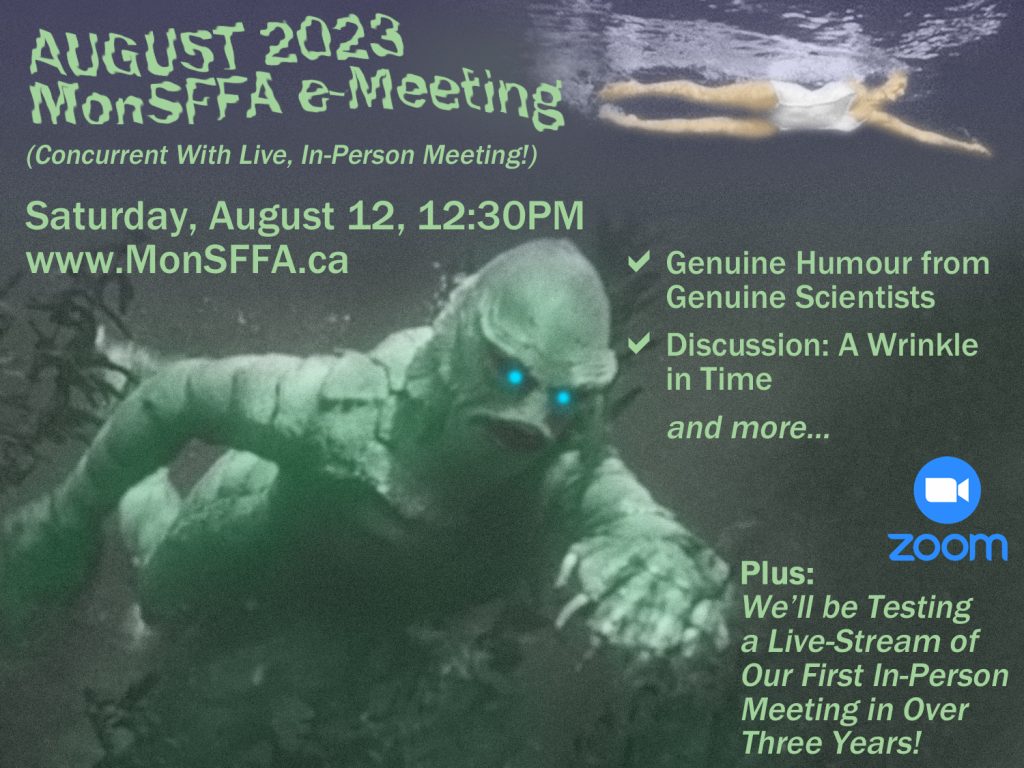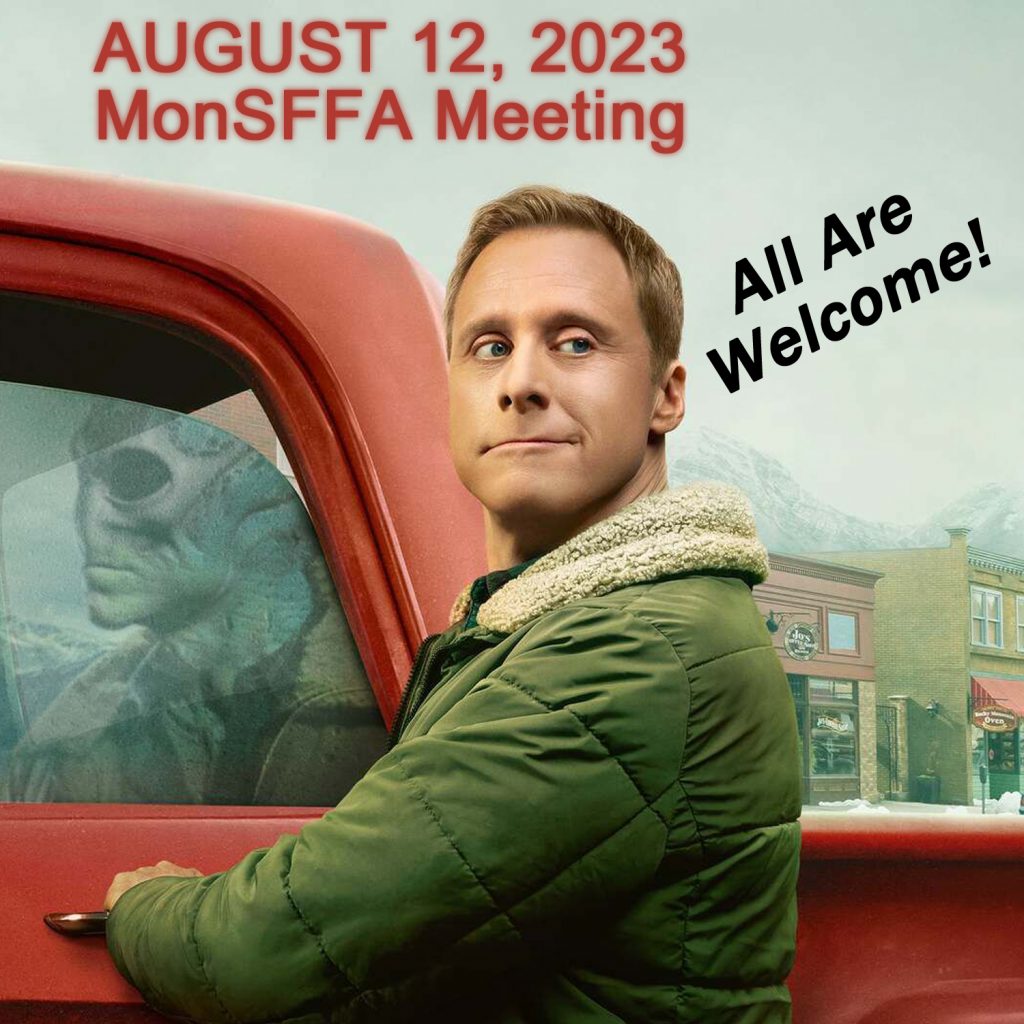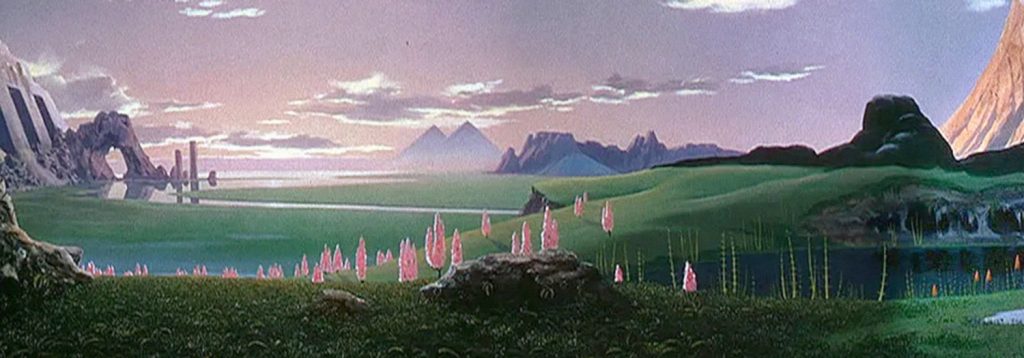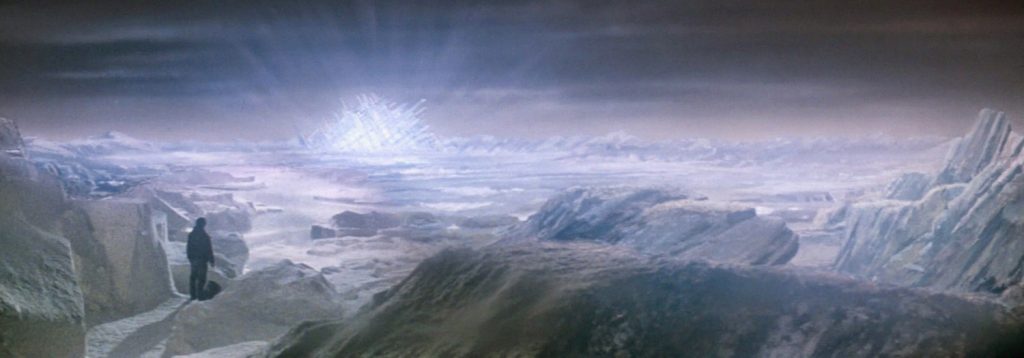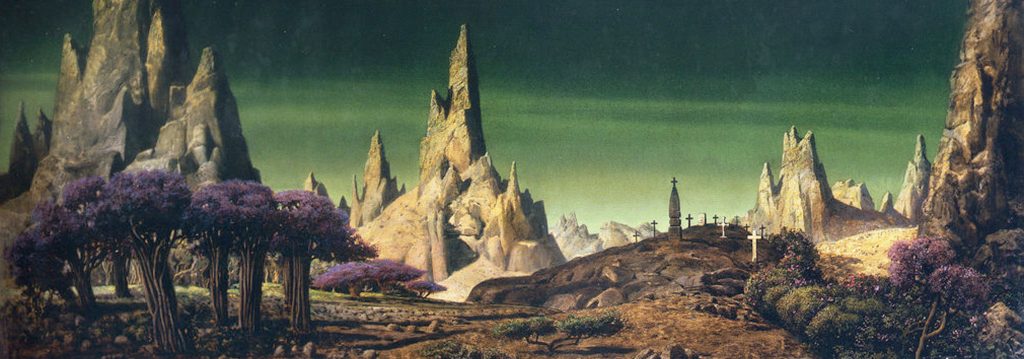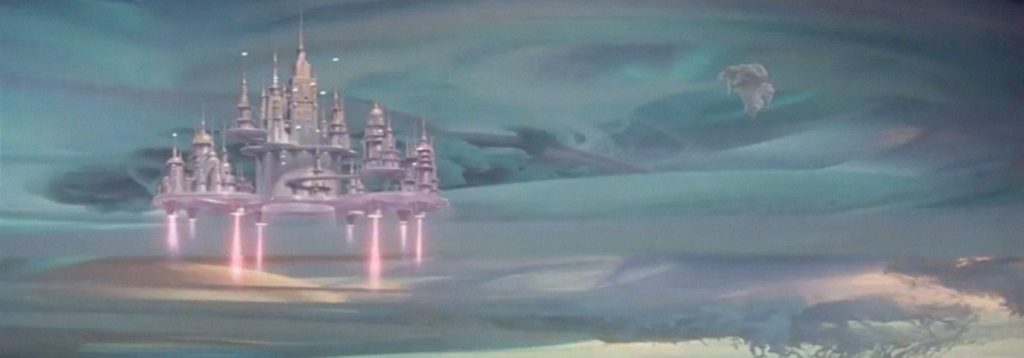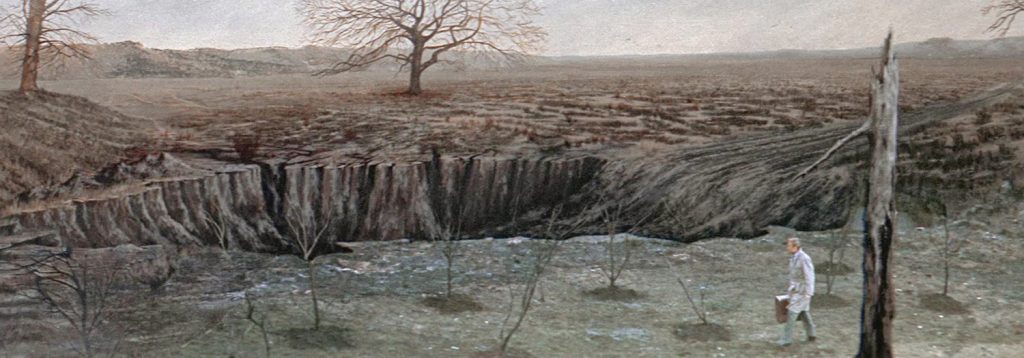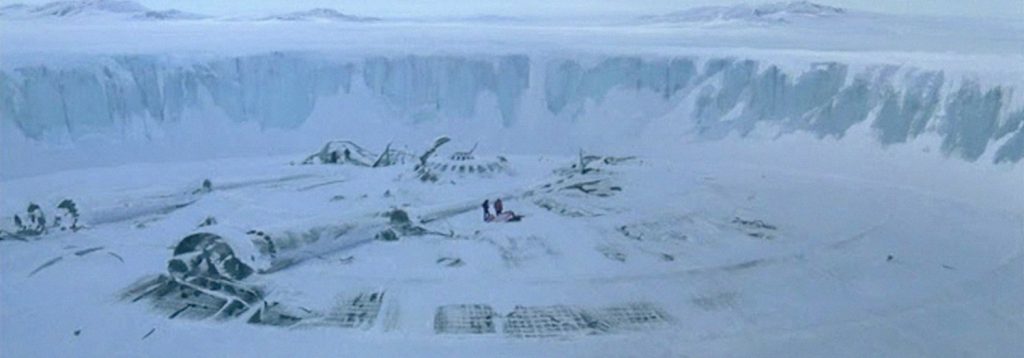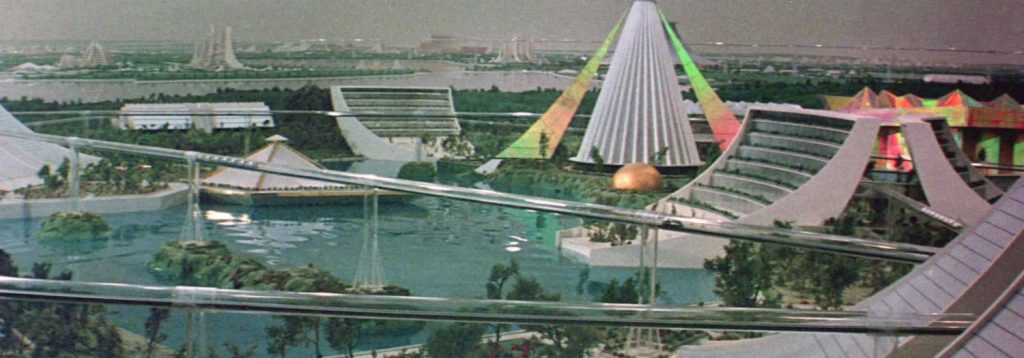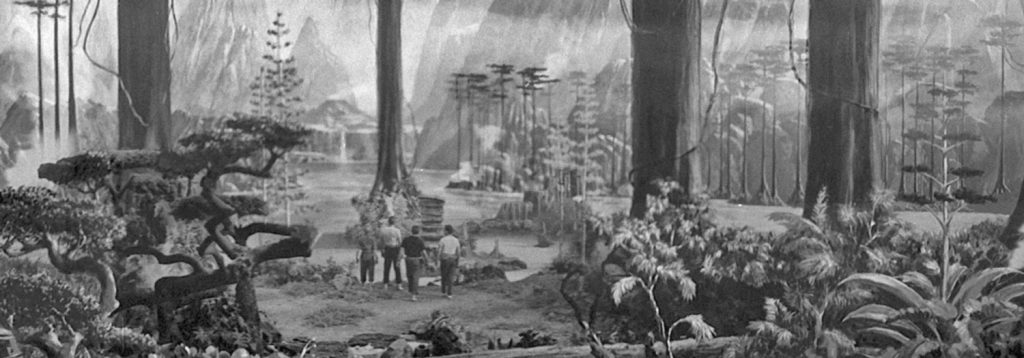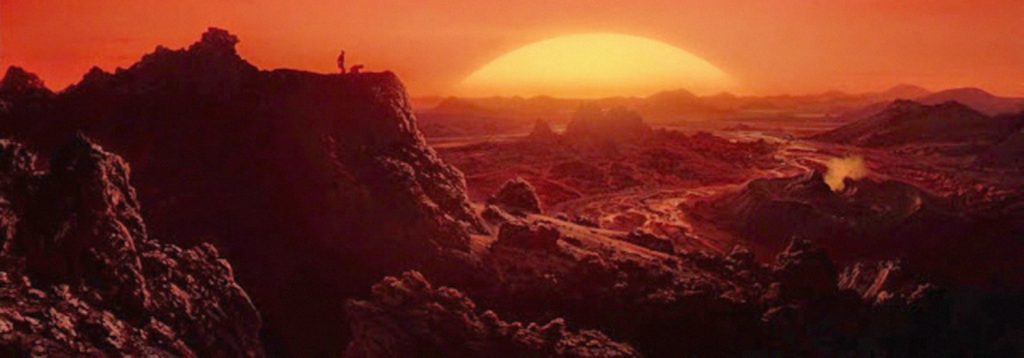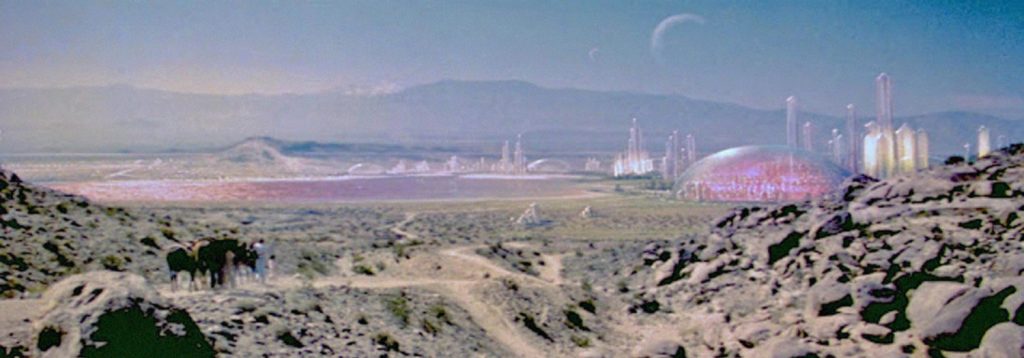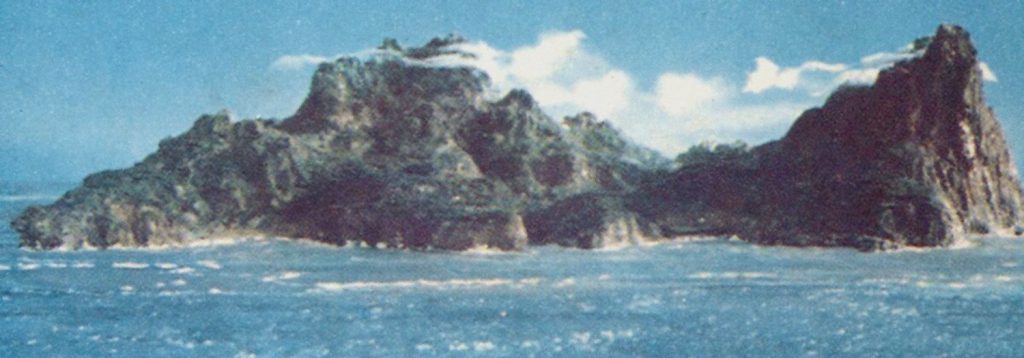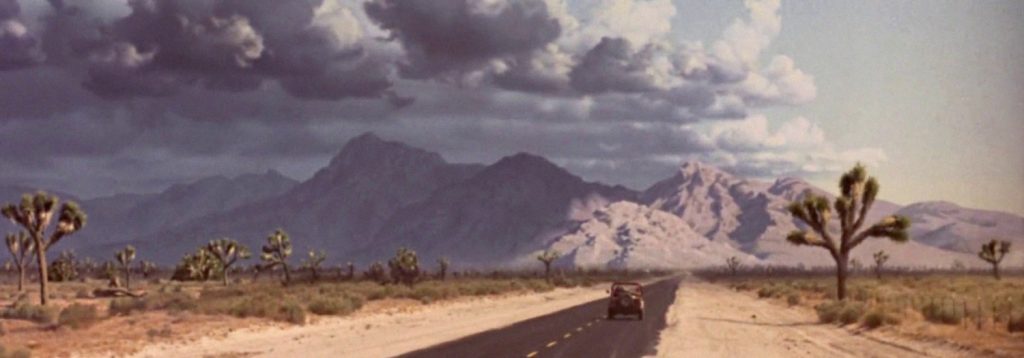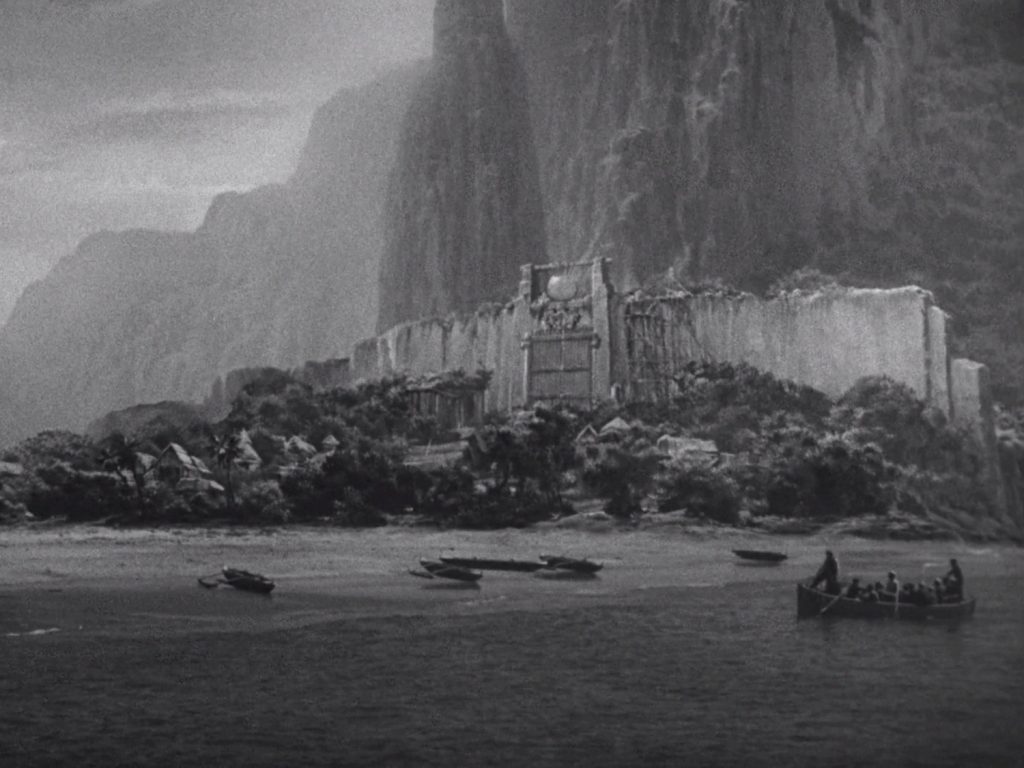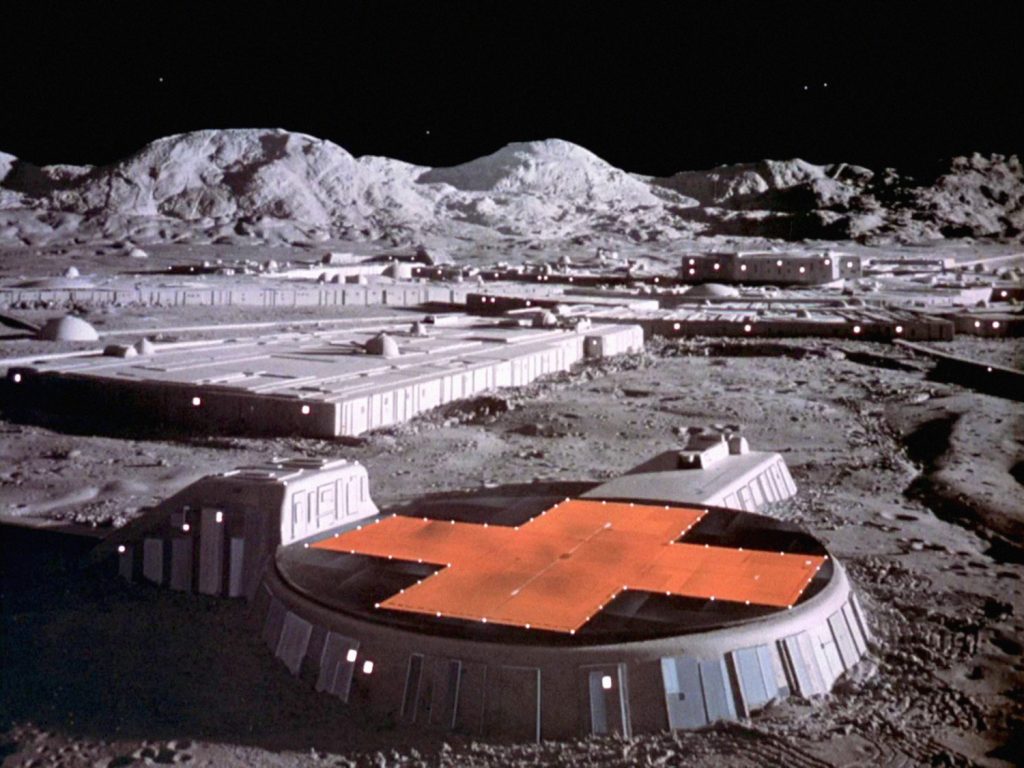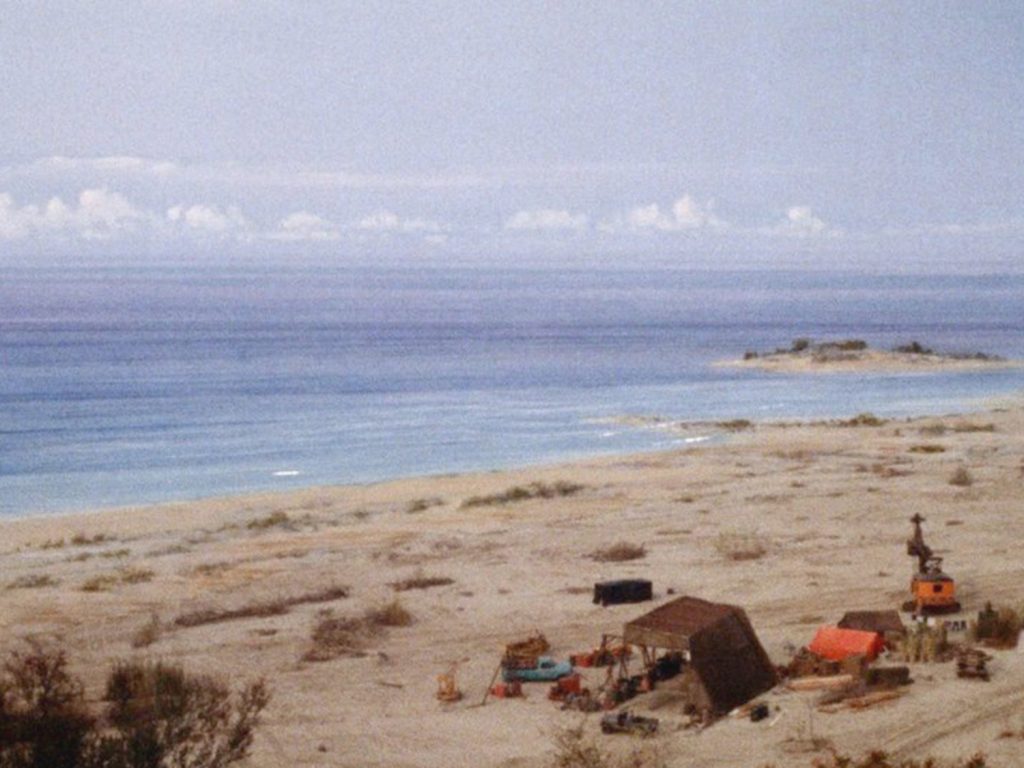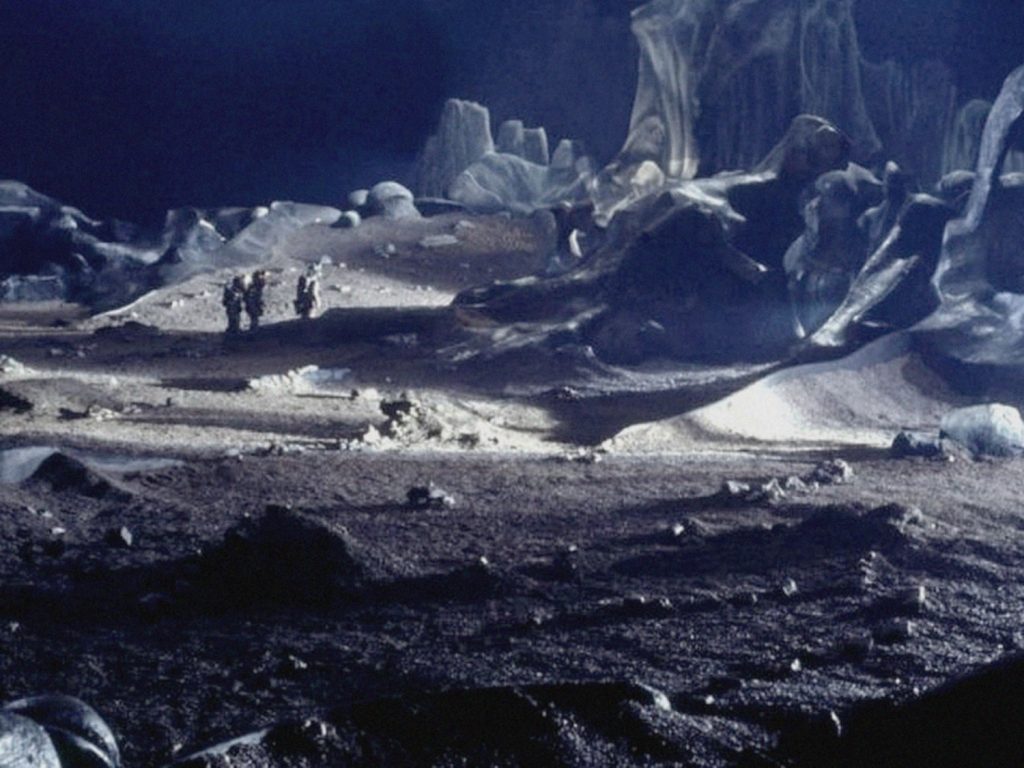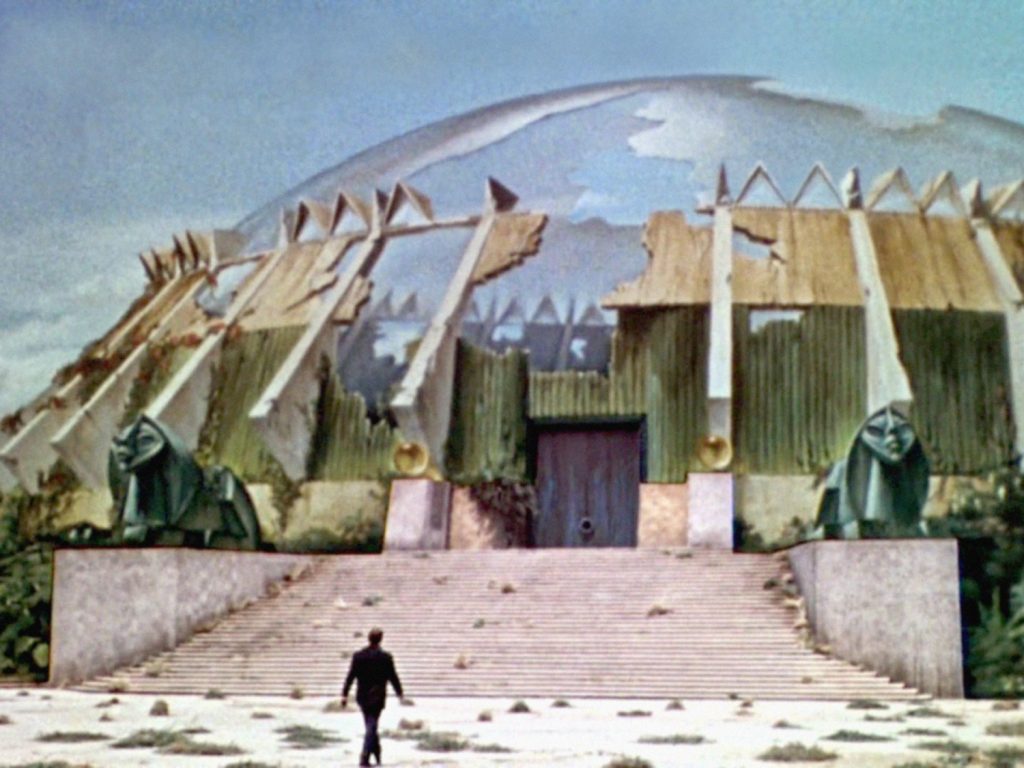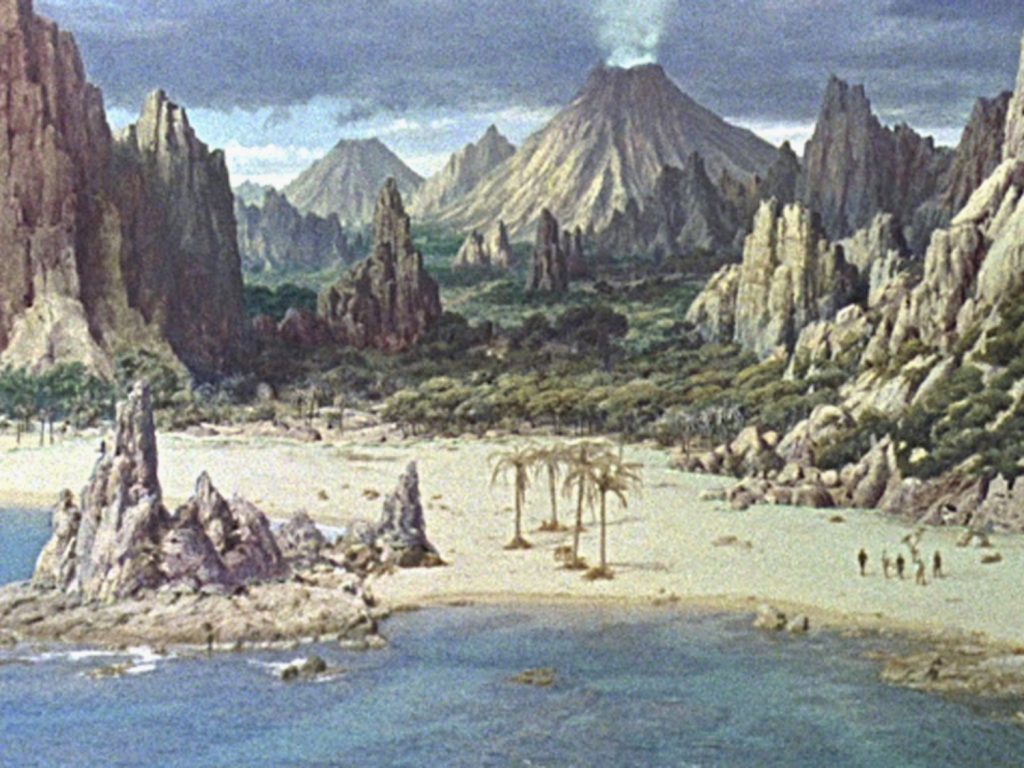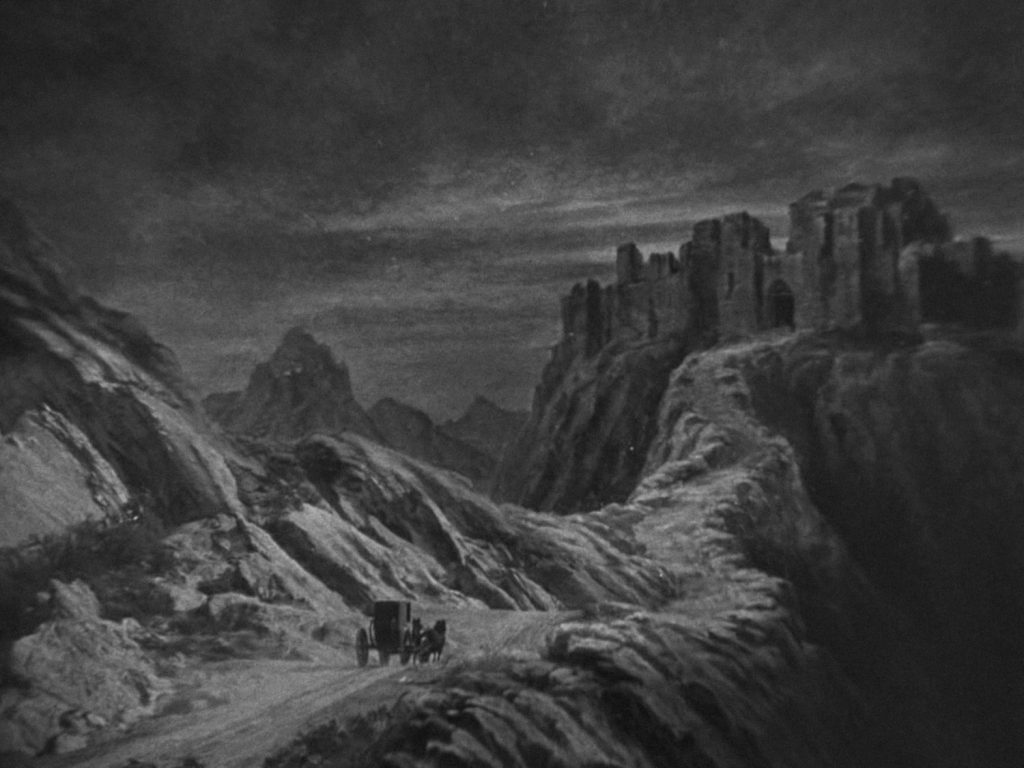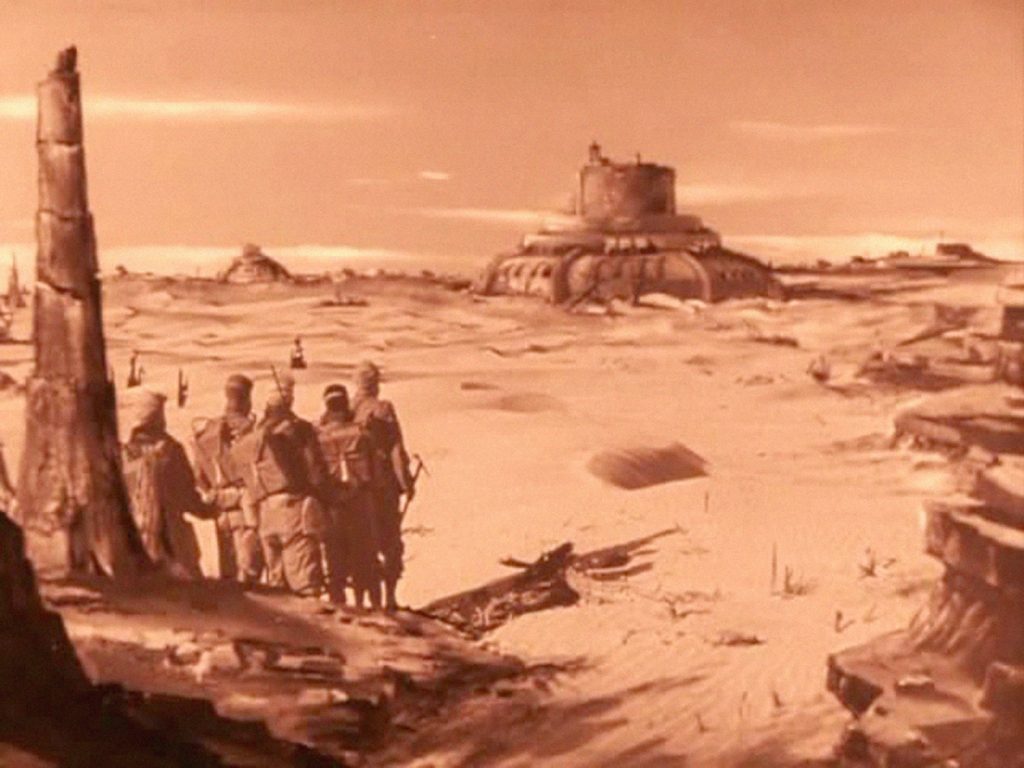All posts by Keith Braithwaite
July 2023 Relax-a-ZOOM, Post 4 of 4: Answers to Quiz and Wrap-Up
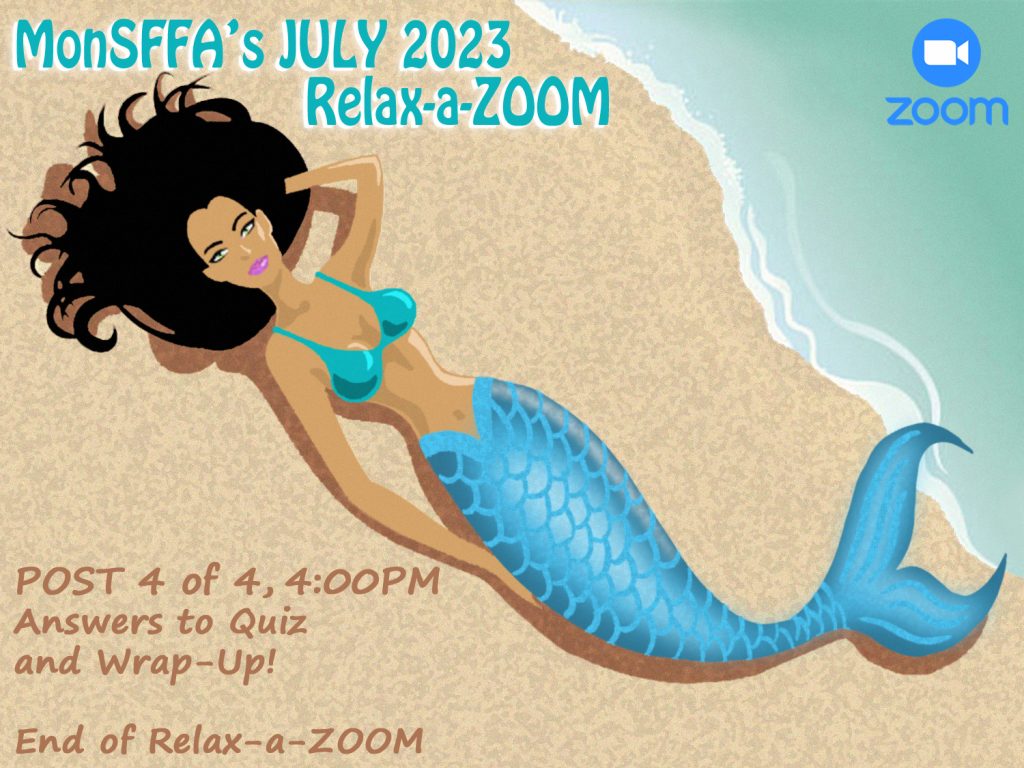 This is the closing post of our Relax-a-ZOOM.
This is the closing post of our Relax-a-ZOOM.
9) ANSWERS TO SF/F GEOGRAPHY QUIZ
A note before we provide the answers to our quiz: the artists and craftspeople who created for the screen these fantastical worlds of the imagination are often the unsung talents of genre filmmaking, sometimes working uncredited. Where information is available, we have given them their due recognition.
Following are the answers to our SF/F Geography Quiz, which we posted at 1:00PM. How well did you fare? Compare your answers to these:
Panoramas
Renowned space artist Chesley Bonestell was engaged to paint this vista of the planet Zyra, to which a rocketship of people escape on doomsday, when the rogue star Bellus collides with and destroys Earth. Zyra had been orbiting Bellus as the two celestial bodies entered our solar system. Passing close to Earth, Zyra just missed striking our planet only days before Bellus ultimately hit, offering humanity’s few survivors a habitable new world.
The story behind this painting is that, apparently, Bonestell had not entirely completed the work when it was hastily conscripted to depict Zyra at the insistence of the studio, who wanted to release the picture as soon as possible in order to capitalize on the popularity of producer George Pal’s previous film, Destination Moon (1950). Effectively pre-production art, the painting was meant to serve as a guide for the construction of a miniature landscape of Zyra, Pal’s original plan, but the studio nixed that idea and he was forced to compromise.
Jan Domela was the uncredited matte artist on this production.
2) The 7th Voyage of Sinbad (1958)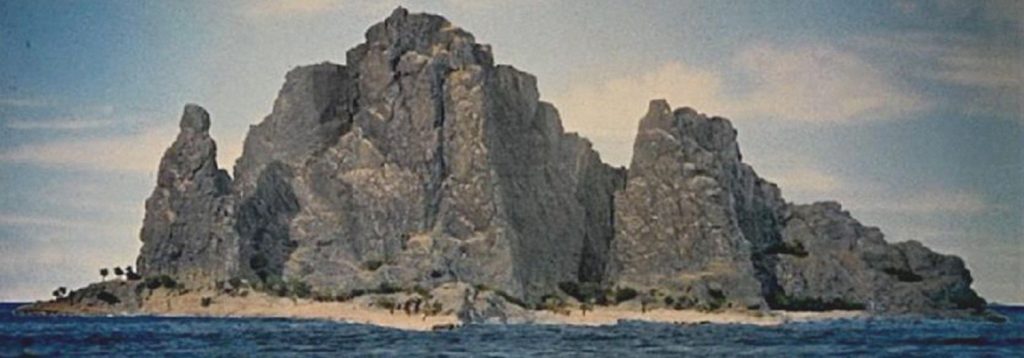
This is the island of Colossa, where Sinbad and his crew encounter a number of mythological beasts, including the monstrous cyclops, who dwell in a valley at the center of the island.
The uncanny denizens of Colossa were brought to life on screen by means of stop-motion animation executed masterfully by Ray Harryhausen, his wonderful creatures performing on miniature sets and melded with previously photographed live-action footage.
Colossa, here, is a miniature with the ocean composited in to complete the shot.
After making his way north, to the Arctic, a young Clark Kent throws a Kryptonian gemstone miles into the distance, where it melts into the ice and gives rise to a crystalline structure, the Fortress of Solitude.
Most of this image is a matte painting produced by the film’s Oscar-winning “mattes and composites” team, headed by Canadian-born Les Bowie, an accomplished matte artist himself, and veteran of Hammer Films.
4) Raiders of the Lost Ark (1981)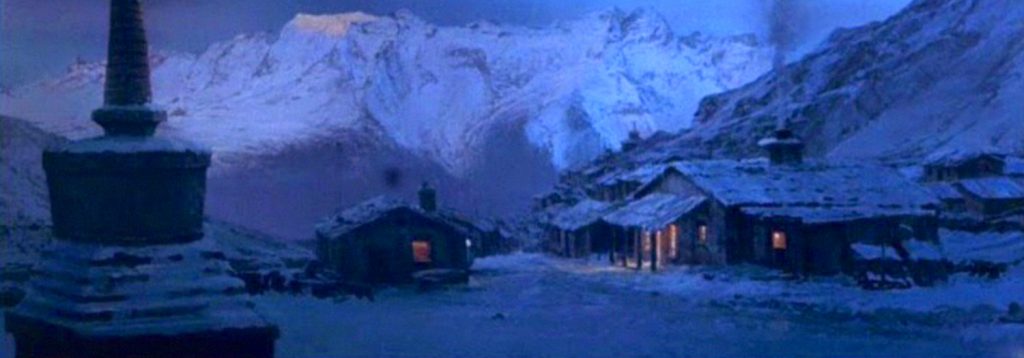
This full painting is of the Raven, circa 1936, Marion Ravenwood’s bar in Patan, on the outskirts of Katmandu in Nepal. Indiana Jones, who was once involved romantically with Marion, comes to the Raven in search of an important archeological piece collected by her father.
The artist, here, is Michael Pangrazio, who was also responsible for the iconic matte painting of the vast secret government warehouse in which the Ark is stored at the end of the film.
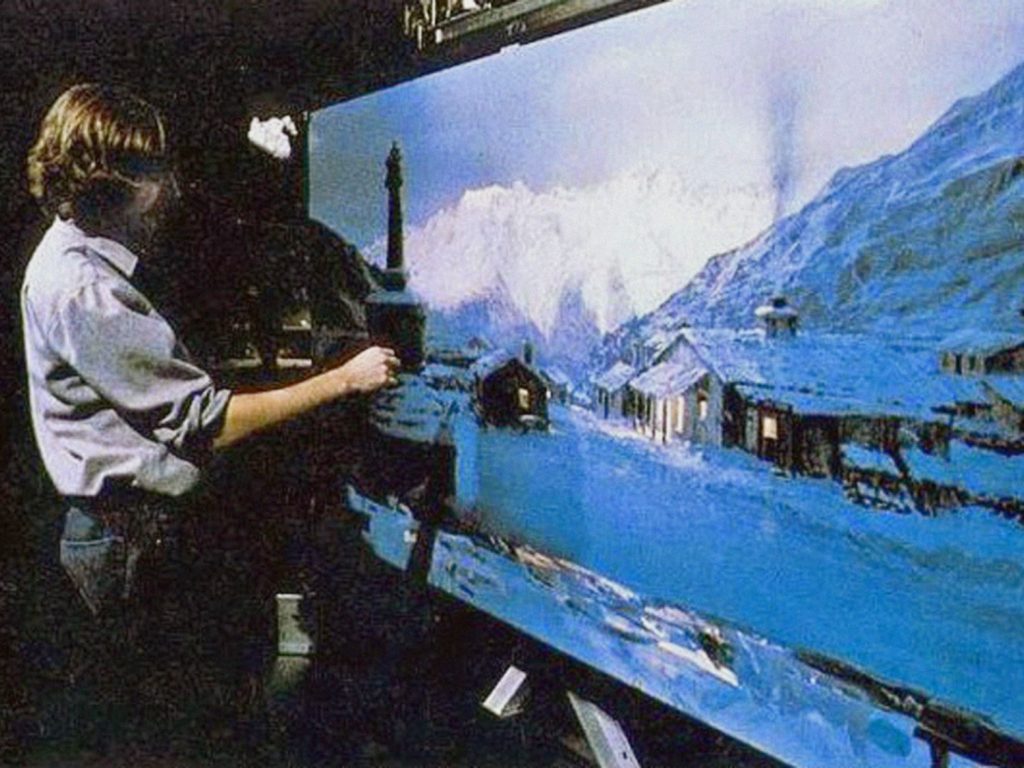
5) First Spaceship on Venus (1962)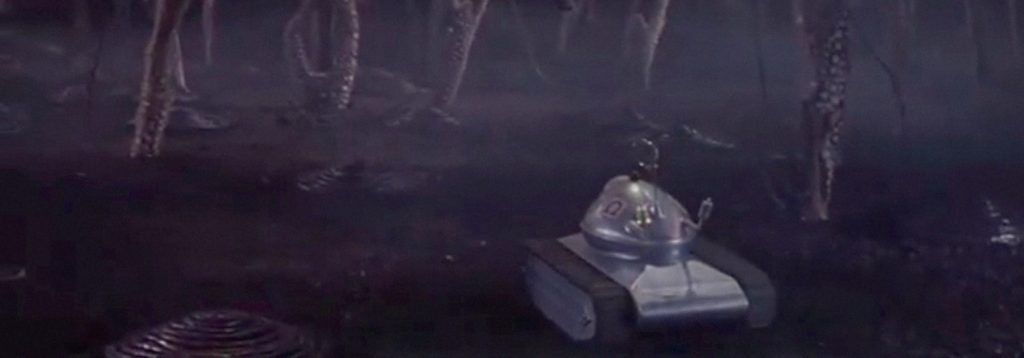
Omega, a robot probe accompanying astronaut-explorers from the rocketship Cosmostrator, negoiates the terrain of atom-blasted, windswept Venus in an example of quality production design from behind the Iron Curtain.
First Spaceship on Venus is the U.S. release of a 1960 East-German/Polish film entitled Der schweigende Stern (German), or Milcząca Gwiazda (Polish)—English translation: The Silent Star. Based on Astronauci—in English, The Astronauts—by Polish science fiction writer Stanislaw Lem, the state-owned East-German production studio, DEFA, made certain that socialist values were reflected throughout the film. First Spaceship on Venus is an English-dubbed, truncated edit of the original; versions were also released under the titles Spaceship Venus Does Not Reply and Planet of the Dead.
This view of the Belleraphon crew’s graveyard on the distant planet Altair IV is a full painting by Henri Hillinck, assisted by his student, Matthew Yuricich, who would go on to become one of the most accomplished practitioners ever of the so-called “Invisible Art.”
The Belleraphon was a spaceship the unknown fate of which brought Captain J. J. Adams and his crew, aboard the United Planets cruiser C-57D, to Altair IV in search of answers. Forbidden Planet was the first science fiction film to portray FTL travel by humans in a spaceship of their own construction, and the first to take place entirely on an alien planet in interstellar space, far, far away from Earth!
This is Sky City, home to the Hawkmen of planet Mongo, one of the locales visited by Gordon and his companions in a flashy (pun intended!) big-screen version of the Buster Crabbe sci-fi/adventure serials of the mid-1930s and 1940.
In this composite of matte painting and live-action footage, American Stephen Reinhart is on his way to visit fiancé Susan Witley at her familial home in Arkham, England and comes across a decimated landscape surrounding a pit on the Witley estate. Toxic radiation emitted by a meteor that crashed on the estate has caused hideous mutations in the local flora and fauna, including Susan’s mother and father, the latter played by horror icon Boris Karloff.
Doug Ferris and Peter Melrose were the uncredited matte painters on this Shepperton Studios production, loosely based on H. P. Lovecraft’s “The Colour Out of Space.”
This is the 100,000-year-old Antarctic crash-site of a flying saucer as pictured in John Carpenter’s terrific feature-film adaption of the 1938 science fiction/horror novella “Who Goes There?” by John W. Campbell, writing as Don A. Stuart.
The tiny figures atop the saucer are actors; master matte artist Albert Whitlock provided the wrecked saucer and surrounding snow-covered landscape.
Described as “the Monet of matte painting,” Whitlock was awarded the Best Visual Effects Oscar for his work on Earthquake (1974), a career-highlight, and repeated in the same category for The Hindenburg (1975). The Thing was among his final projects.
The movie’s sprawling city of the future is a detailed miniature akin to a large model railroad set-up.
In the 23rd century, the populace enjoy a hedonistic lifestyle within this utopian, computer-controlled, domed city. But the whole thing is a façade; this is, in reality, a dystopia as people have imposed upon them a shortened lifespan in order to keep population numbers and a limited food supply in balance. Couched in quasi-religious ceremony so as to assuage the public, all citizens are compelled to undergo the rite of “Carrousel” at age 30, in which they are systematically killed with a promise of “Renewal.” It’s all a lie, and those who attempt to flee the city so as to dodge their fate are called “Runners,” and are hunted down and executed by a special police force, the “Sandmen.”
The special effects team that earned an Academy Award for its work on this film included matte artist Matthew Yuricich, whose depictions of Washington, D.C., a dead city overgrown with vegetation, are entirely convincing.
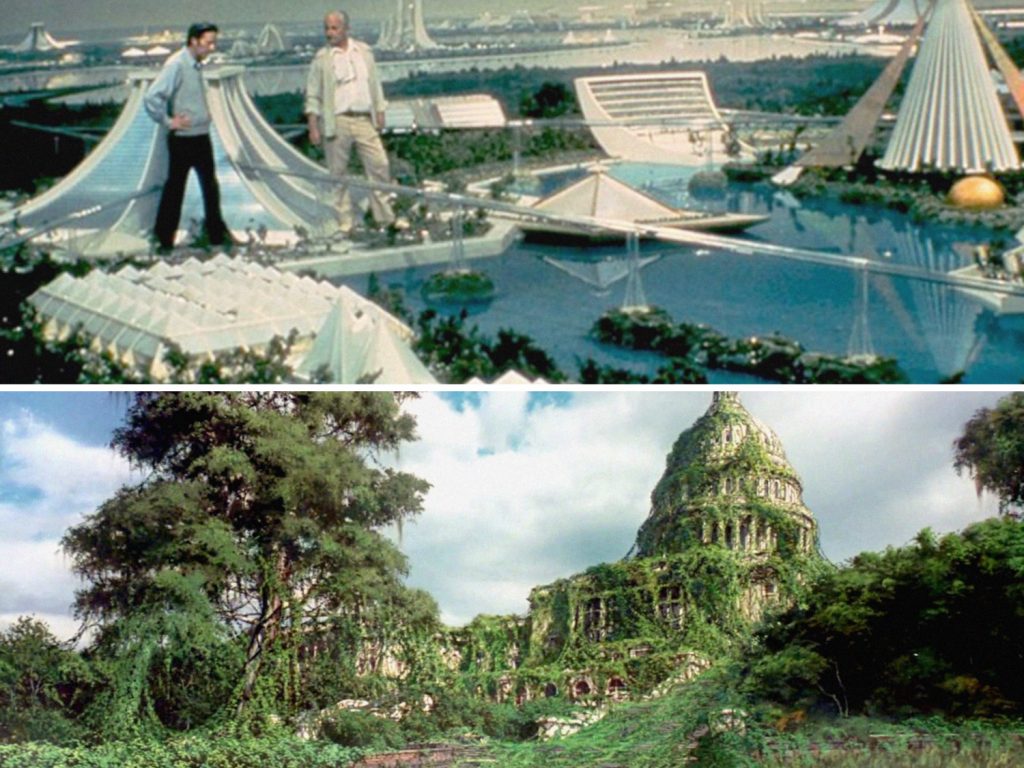
The film’s protagonists are awestruck by the scene before them, that of a steamy prehistoric jungle world they have discovered deep within an Antarctic crater.
Much of the action was filmed on a studio set ringed by a huge painted backdrop called a cyclorama. For wide shots, the actors were composited into miniature sets populated by dinosaur puppets or crewmembers dressed in dinosaur suits.
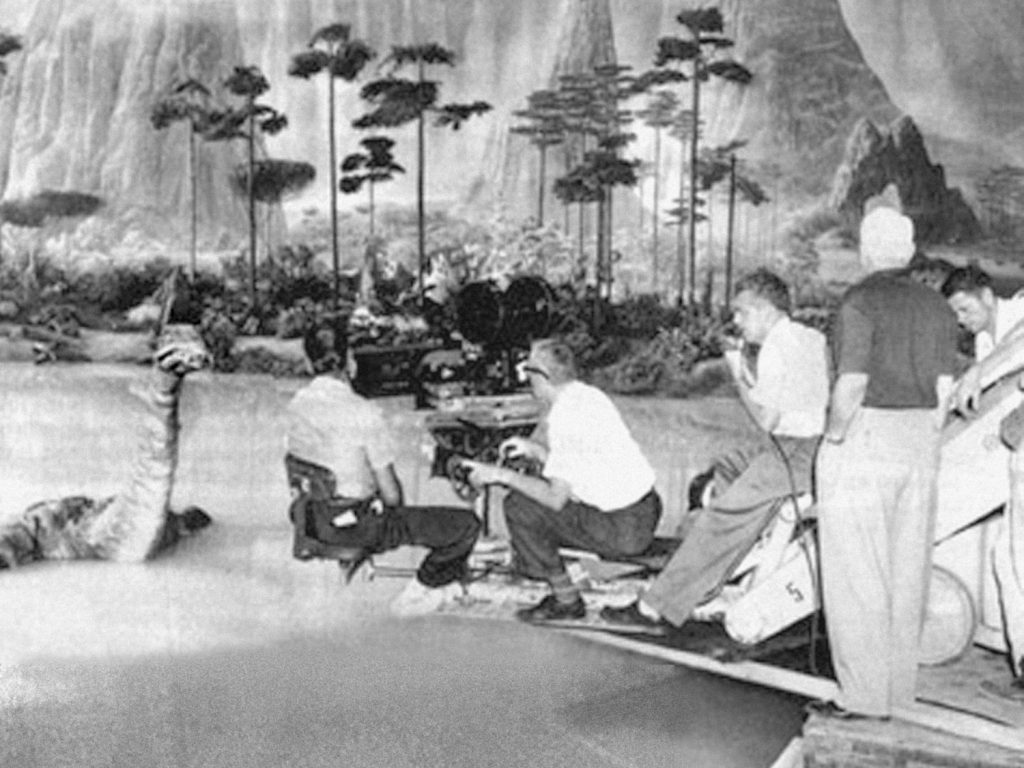
12) Colossus: The Forbin Project (1970)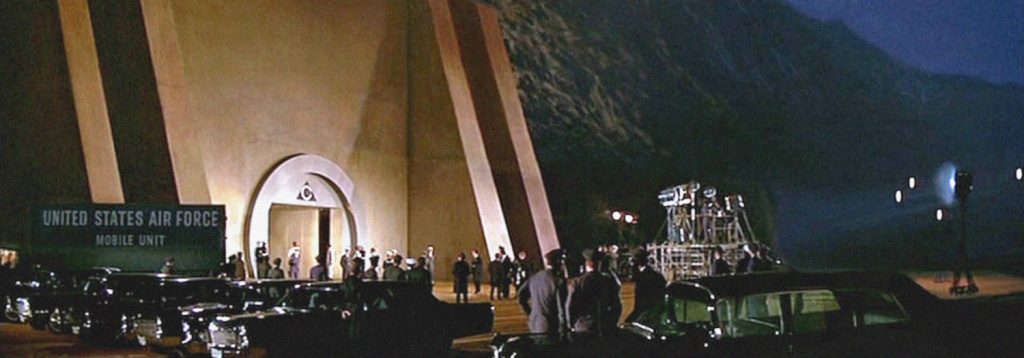
This is the exterior of the military installation carved into a Colorado mountain that houses defense supercomputer Colossus. Once Colossus is activated and the vault shut, the complex will be impregnable.
Celebrated matte artist Albert Whitlock provided several beautifully rendered oil-on-glass mattes for this film.
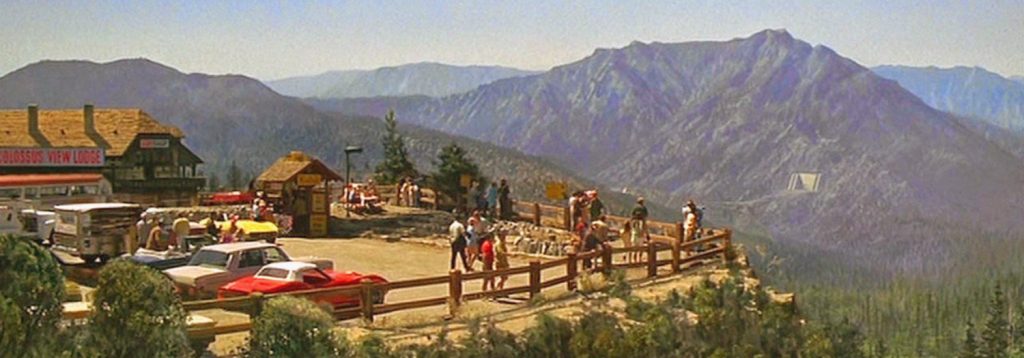
This is the inhospitable, largely volcanic planet Fyrine IV.
During an interstellar war pitting the human race against the reptilian Dracs, two opposing fighter spacecraft engage in a dogfight that ends with both ships crash-landing on Fyrine IV, where the human pilot and his Drac counterpart must set aside hostilities and cooperate in order to survive. The two eventually become fast friends.
Matte artist Sean Joyce was reportedly inspired by a similar Albert Whitlock-rendered sunset scene in Greystoke: The Legend of Tarzan, Lord of the Apes (1984).
The “City of Light” is a domed city of the far-flung future featured in this movie’s closing scene.
Jim Danforth, also known for his stop-motion animation work, painted the matte.
15) Star Trek II: The Wrath of Khan (1982)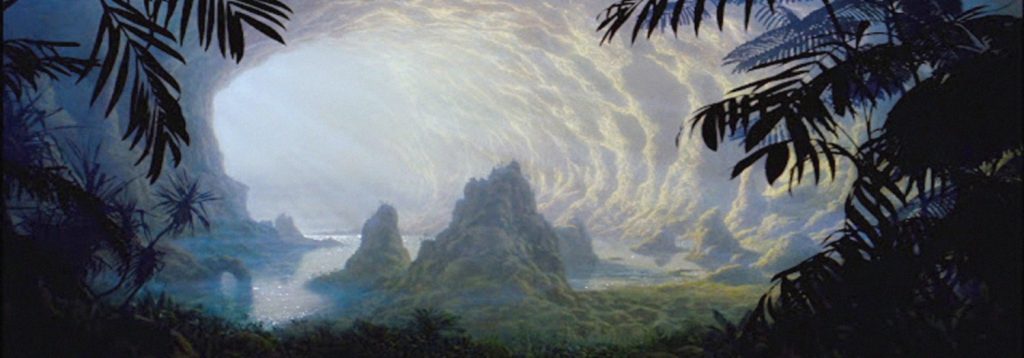
This is the Genesis Cave, as any Trekker will attest!
ILM’s Chris Evans and Frank Ordaz shared matte painting duties on Wrath of Khan.
16) Robinson Crusoe on Mars (1964)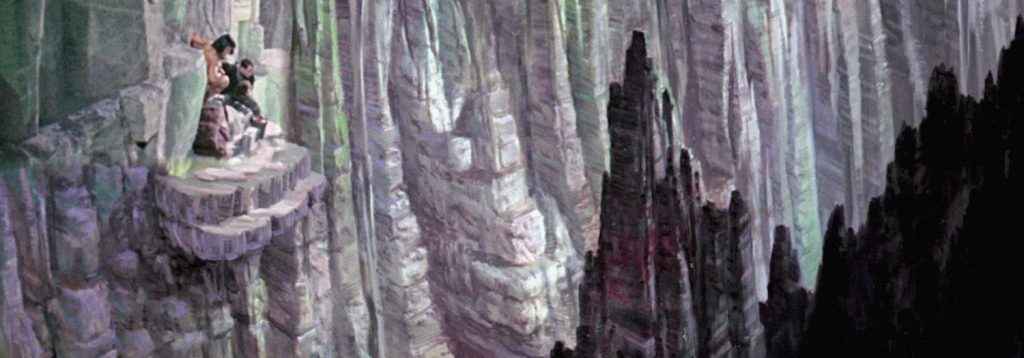
An uncredited Albert Whitlock lent his talents to the production as matte artist, producing several striking paintings, including this colossal Martian cave dwarfing the actors composited into the shot.
The movie offered a sci-fi take on the classic Daniel Defoe story.
This is Solgell Island in the South Pacific, site of weather-control experiments by scientists, and the birth place of Minilla, the adopted son of Godzilla!
Son of Godzilla was the title given the English-language dub of the original Japanese Kaijū-tō no Kessen: Gojira no Musuko, the literal translation of which reads “Monster Island’s Decisive Battle: Godzilla’s Son.” In 1969, Son of Godzilla was released theatrical in the U.K., but premiered in the U.S. not in movie houses, but on television.
With special effects by Sadamasa Arikawa, supervised by the franchise’s venerable Eiji Tsuburaya, the movie’s principal monsters were portrayed by actors in suits performing on miniature sets. The various other giant creatures of the piece were puppets.
Solgell Island was, effectively, what became known as Monster Island in later films.
Having survived her encounter with the Terminator, the film’s epilogue follows a pregnant Sarah Conner, who drives her Jeep into Mexico recording explanatory audio tapes. These she will one day pass on to her as yet unborn son, John, future leader of the Resistance. The closing shot sees her pull out of a gas station after filling up and drive away, down a desert highway into the coming storm.
Much of that composite shot is a matte painting by Ken Marschall, better known for his exceptional paintings of the ill-fated ocean liner Titanic.
Standard Frame
This is Skull Island. Visible are the beach, native village, and huge wall built to keep separate from the natives Kong, the dinosaurs, and other dangerous creatures that dwell on the island.
Byron L. Crabbe, Mario Larrinaga, and Henri Hillinck served uncredited as matte painters on this production; these gentlemen are among the pioneers of the process.
20) The Crater Lake Monster (1977)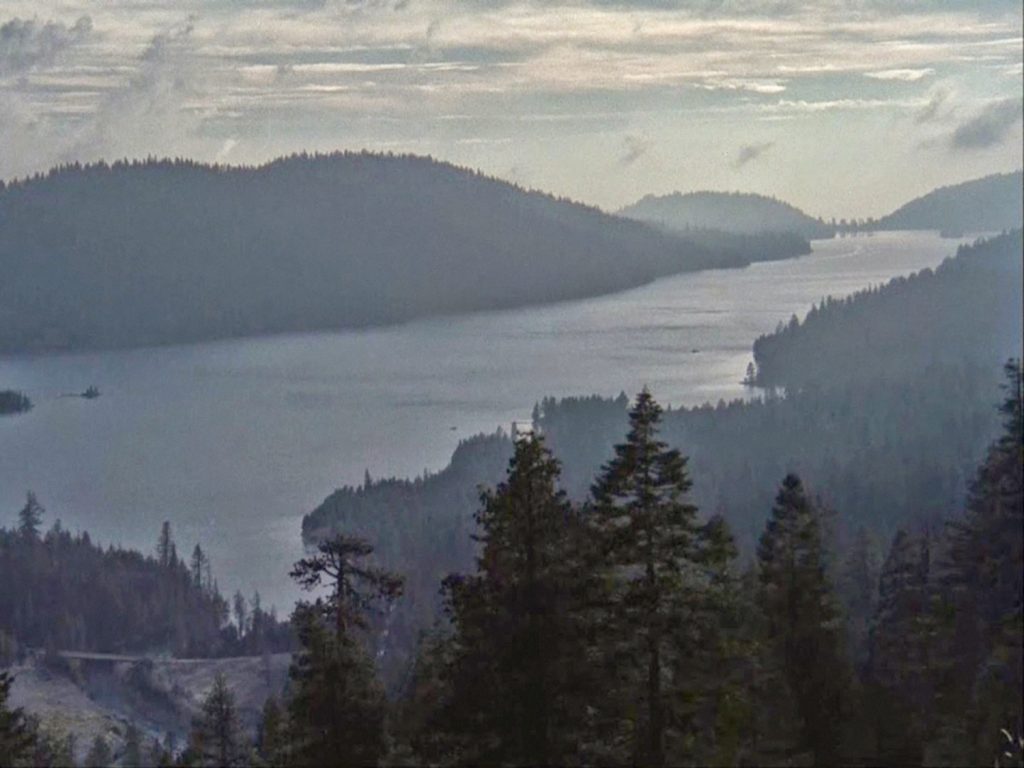
This is Crater Lake, California, setting of Crown International Pictures’ critically-panned, micro-budget B-movie about a Loch Ness monster-like plesiosaurus dining on tourists and townspeople. While the production shot on location at Huntington Lake, California, Crater Lake is a real-world locale in the northern region of the state, not to be confused with the well-known lake of the same name in Oregon, key feature of Crater Lake National Park.
The titular monster was brought to life by means of stop-motion animation, supervised by David “Dave” Allen, who was assisted by Jim Danforth and Randall William Cook, with Phil Tippett pitching in building miniatures. All but Allen working uncredited. Their collective efforts are the only thing about this truly awful, amateurish film that merits a look!
Pictured is Moonbase Alpha, principal setting of this British sci-fi television series created and produced by Gerry and Sylvia Anderson. In the year 1999, Moonbase Alpha, staffed by more than 300 personnel, is launched on a trajectory towards the unknown when a massive explosion at a nuclear-waste storage site on the far side knocks out of orbit and hurls the Moon uncontrollably out into deep space!
With the cutting-edge visuals of 2001: A Space Odyssey (1968) as inspiration for the show, the production drew upon 2001 alumnus Brian Johnson to serve as special effects director. Skilled model-makers Andrew Kelly and Martin Bower were recruited, as well.
Measuring some 12 feet in diameter, the Moonbase Alpha model was built of plywood sections, sheet and vacuum-formed plastic, and Perspex, with various commercial model-kit pieces affixed as surface detail. Reflective tape was used to craft windows. The surrounding lunar surface was formed with Plaster of Paris, and the distant mountains were simply black-and-white photographs enlarged and mounted on board.
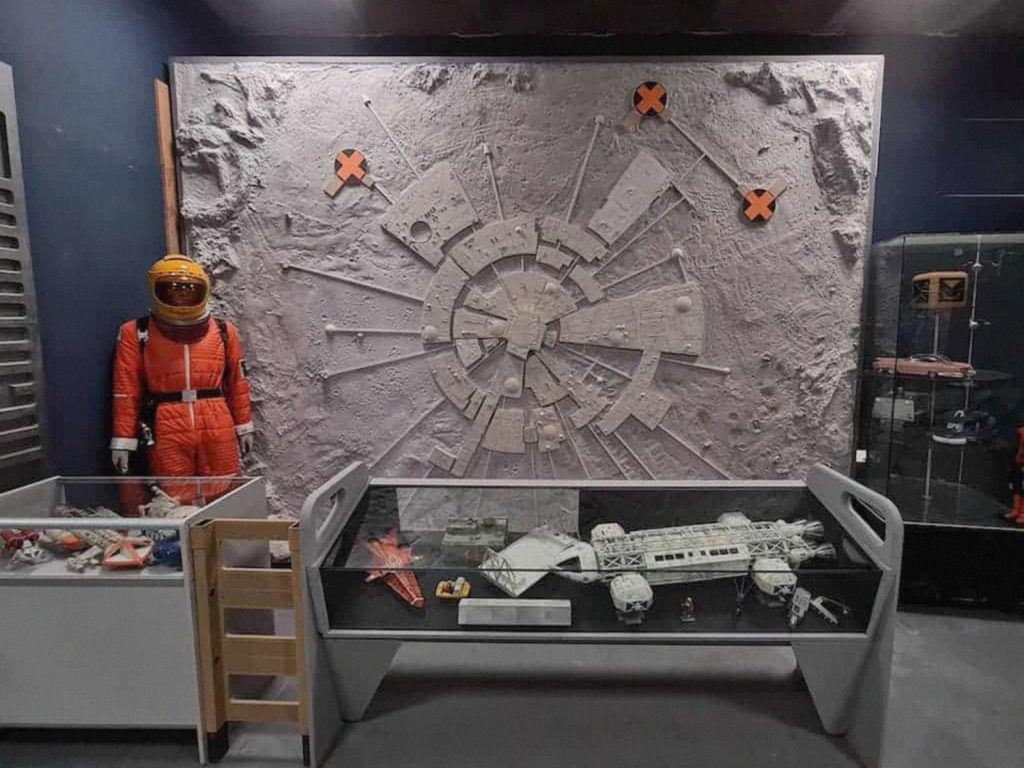
22) Star Trek—The Devil in the Dark (1967)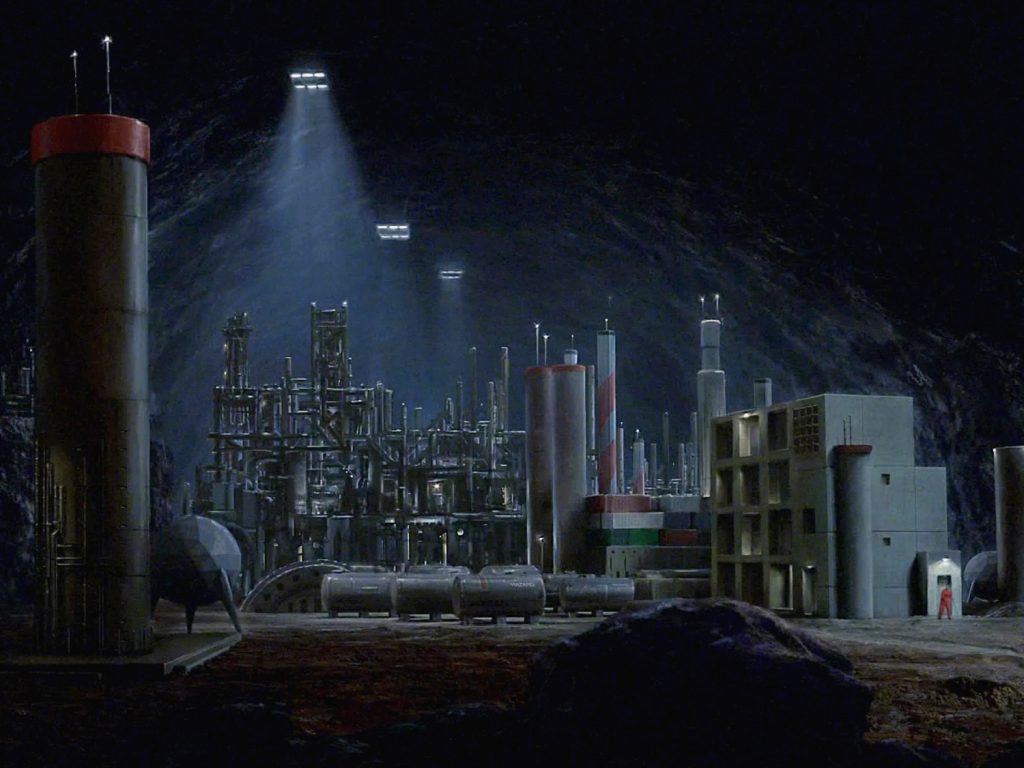
This is the pergium mining station on Janus VI, as seen in the remastered Star Trek episode “The Devil in the Dark.”
Max Gabl was assigned to create CGI imagery for the remastered version of this original series episode. Pictured is his digital matte painting of the mining facility. Live-action footage of an actor was composited in, bottom right corner of the frame.
In the late-1960s, Albert Whitlock was subcontracted to produce all of the matte paintings used in Star Trek, including the original establishing shot of the mining station, which was later repurposed as a backdrop in “The Gamesters of Triskelion” (1968). His magnificent Rigellian fortress is probably the most recognized of the many paintings he produced for the illustrious science fiction television series.
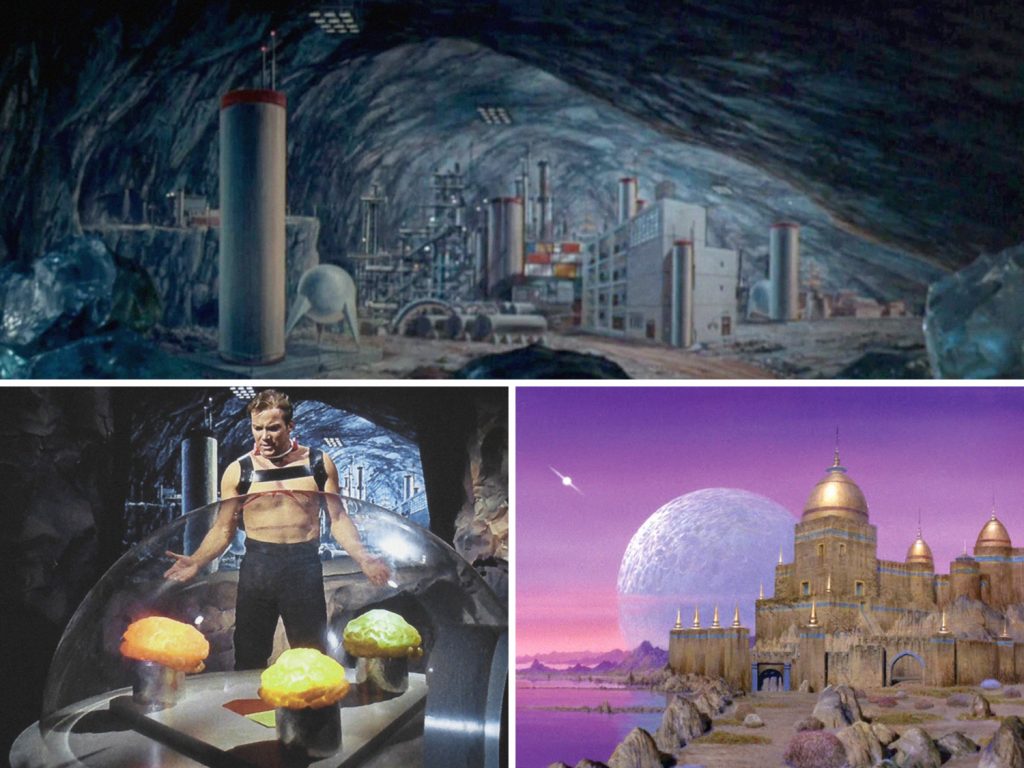
This is a small, uninhabited island about 200 miles off the east coast of Africa, on which a construction crew are in the process of building an airstrip for the Warburton company in advance of a planned oil-drilling operation.
Eons ago, this very locale was the site of a strange meteor impact. When the crew uncover the long-buried space rock during the course of their work, a glowing electric-blue light is emitted from the boulder, enveloping their large bulldozer and somehow imbuing the vehicle with a form of alien energy, a rudimentary sentience, and a homicidal bent!
Based on Theodore Sturgeon’s 1944 novella of the same name, Killdozer! was a made-for-TV movie that originally aired on the ABC network.
The movie was shot on location at Indian Dunes, a film ranch in Valencia, California. Albert Whitlock handled the production’s “special photographic effects.”
An EVA is underway, here, on the surface of LV-426 (later given the name Archeron), a moon orbiting the gas giant Calpamos in the Zeta II Reticuli system.
It is here that the doomed crew of the commercial starship Nostromo discovered the deadly Xenomorph, with only Warrant Officer Ellen Ripley surviving the encounter.
This was one of three large film sets built at Shepperton Studios for the production of Alien, the other two being the interiors of the Nostromo and the derelict spaceship. Wood and Fiberglas forms based on conceptual artist H. R. Giger’s designs were constructed and painted, and the set was dressed with tons of sand, gravel, and rock.
25) The Trollenberg Terror (1957)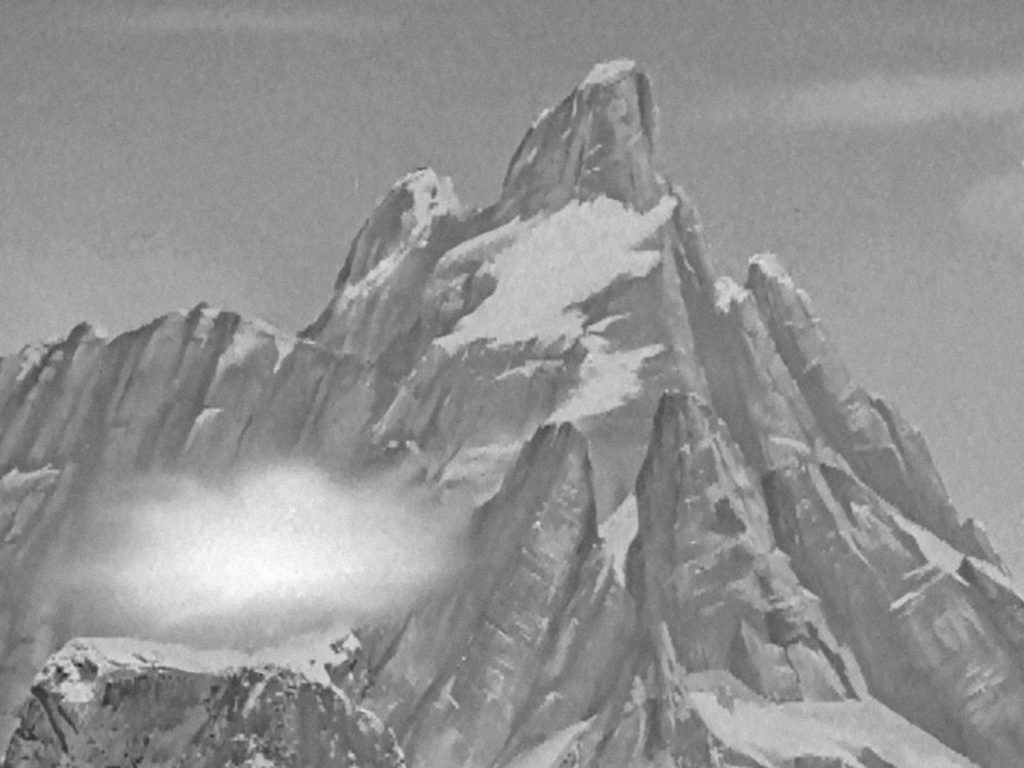
This view is of the fictional Mount Trollenberg in the Swiss Alps, where an odd cloud hugs the mountainside, concealing one-eyed, tentacled monsters! The British sci-fi/horror film was released in the U.S. as The Crawling Eye.
Les Bowie and assistant Brian Johnson executed the special effects, uncredited. The shot pictured here is a full painting onto which was affixed a cotton-wool cloud.
Approaching the ruins of the Eloi temple in this composite shot is Rod Taylor, as the time traveller identified only in dialogue as “George,” after both the film’s producer, George Pal, and science fiction author Herbert George “H. G.” Wells, whose story was the basis for the film.
Bill Brace was the uncredited matte painter on The Time Machine. The stairs in this shot were built for the film Kismet (1944) and saved for future use by a forward-thinking MGM executive; the rest of the temple is a Brace matte painting.
Designer/sculptor/model-maker/animator Wah Chang built the iconic time machine prop from a design by MGM art director Bill Ferrari. The film’s “time-lapse” effect, depicting the passage of years and centuries in mere minutes, earned the production’s special effects team an Oscar.
Largely a matte painting, this is a bird’s-eye view of the titular island, setting for a classic Jules Verne science fiction/adventure.
Regarding special effects, peerless stop-motion animator Ray Harryhausen is most associated with this movie. The matte artist who produced the painting, here, is uncredited; speculation by film historians believe credit is likely due either Les Bowie or his protégé, Ray Caple.
28) Jack the Giant Killer (1962)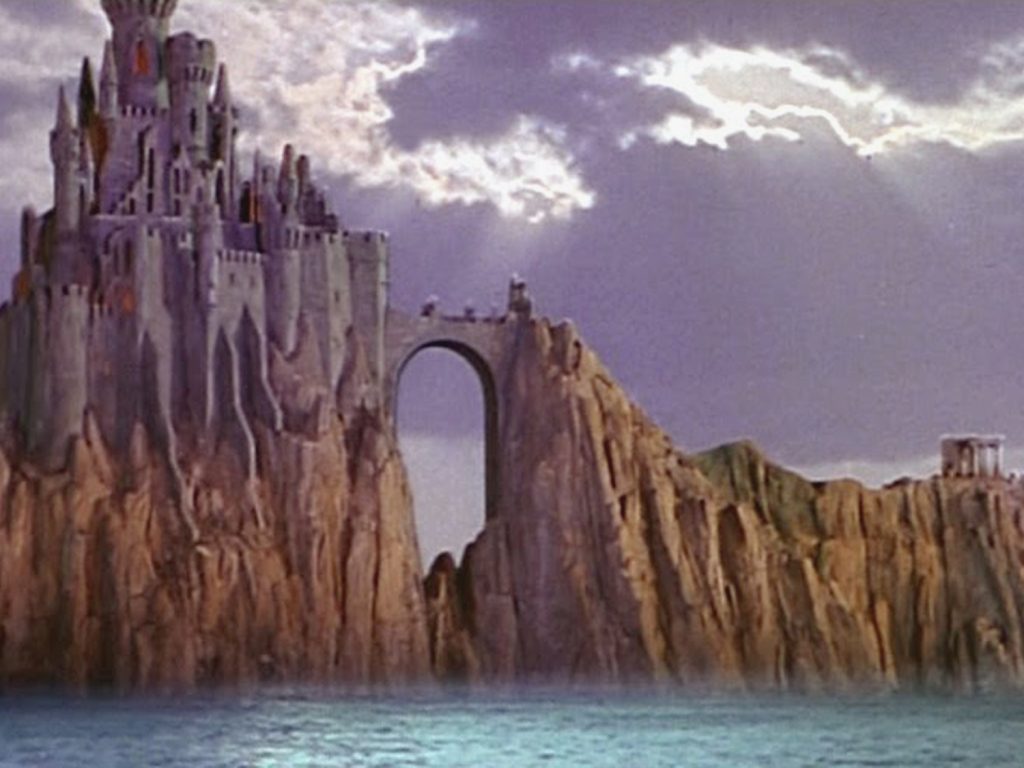
The grand castle of the tale’s evil sorcerer, Pendragon, is seen in this composite shot put together around Bill Brace’s matte painting of the imposing island fortress.
A blatant attempt to cash in on the popularity of The 7th Voyage of Sinbad (1958), many of the top young stop-motion animators and model-builders of the time worked on this movie, some credited, others not. They included Wah Chang, Tim Baar, Gene Warren, Tom Holland, and Jim Danforth.
A carriage makes its way up a steep, winding road in the Carpathian mountains towards baleful Castle Dracula.
The uncredited matte artist, here, was John P. Fulton, who worked his way up the ladder from assistant cameraman to cinematographer and eventually, head of the special effects department at Universal Pictures, and later Paramount Pictures. The classic Dracula was one of Universal’s series of popular horror films, circa 1930s-1950s.
Fulton, whose career spanned some four decades, is remembered in particular for his eye-catching work on The Invisible Man (1933) and its sequels, for his parting the Red Sea in The Ten Commandments (1956), and for the innovative special effects work in Alfred Hitchcock’s Vertigo (1958). Nominated multiple times in the Special Photographic Effects category, he was a three-time Academy Award-winner.
30) Cat-Women of the Moon (1953)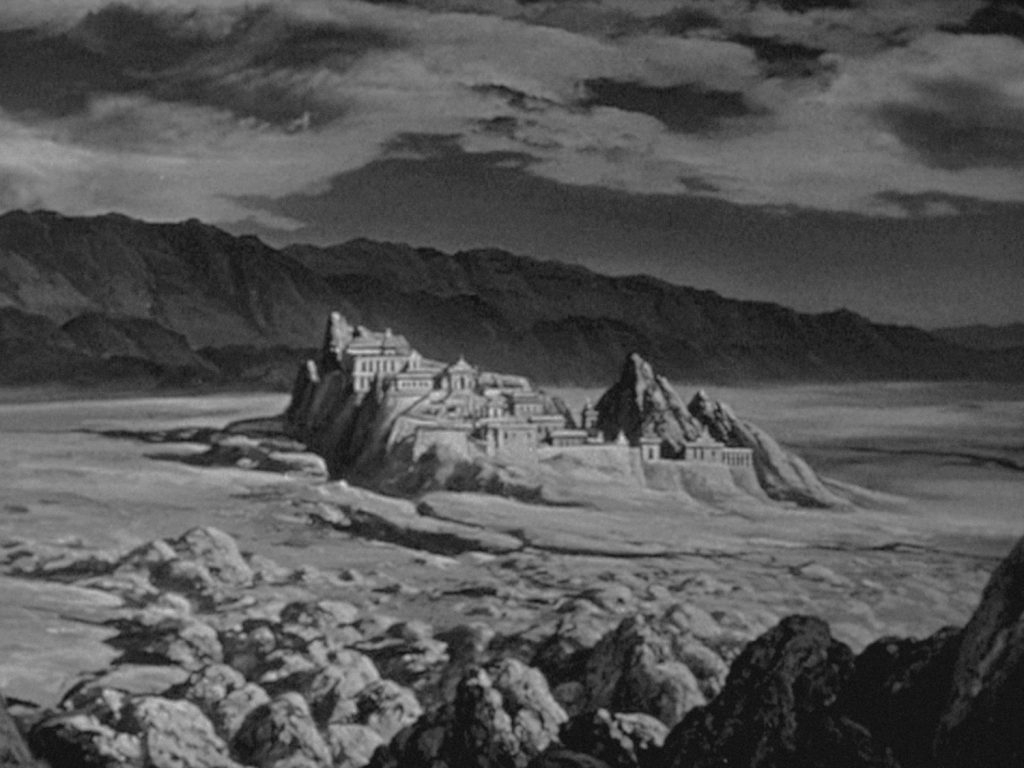
This is the moon city in which dwell the telepathic cat-women, who don black leotards, adorn themselves with pronounced mascara, and perform ritualistic dances. Their lunar oxygen supply diminishing, the cat-women plan to travel to Earth aboard a stolen spaceship and employ their telepathic powers to take over the world!
Co-producers Jack Rabin and Al Zimbalist came up with the story, and also saw to the film’s special effects, with associate Irving Block producing matte paintings for the film. Moonscape paintings were courtesy Chesley Bonestell, and Wah Chang fabricated a giant spider puppet for the sequence in which the Earth astronauts battle the eight-legged monster deep within the moon’s caverns. Block, Bonestell, and Chang were all uncredited.
31) The Time Tunnel (1966-1967)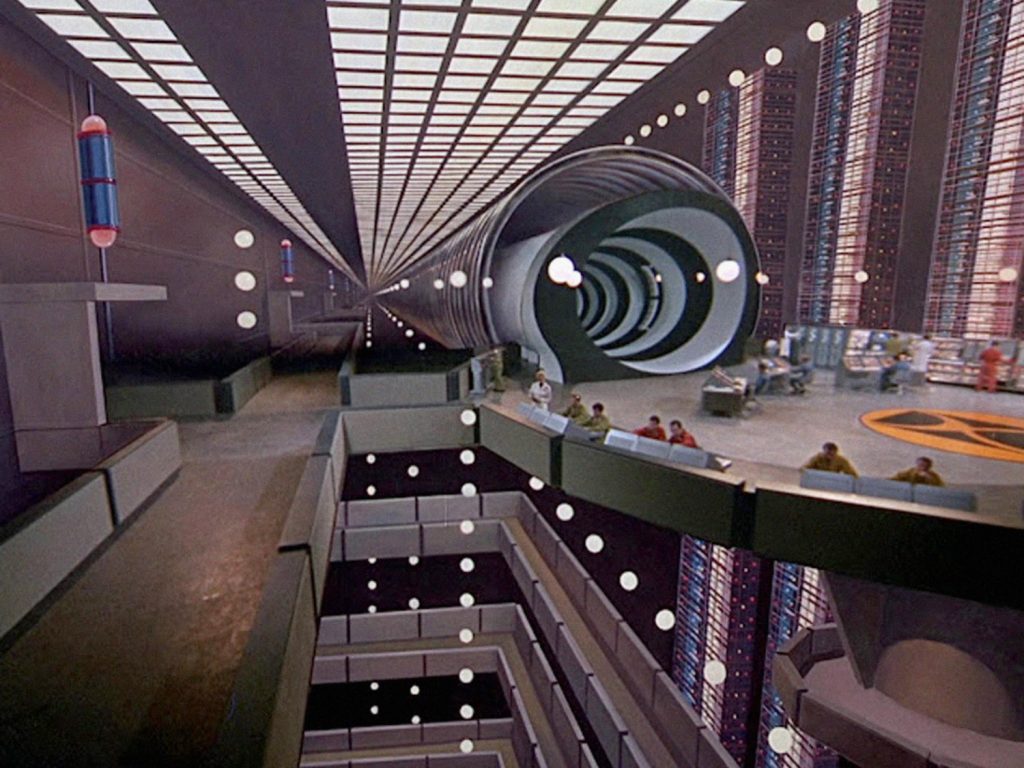
Project Tic-Toc, housed in a vast underground complex in Arizona, is a secret government experiment undertaking to construct a time machine. This establishing shot shows the resultant Time Tunnel and adjacent control room within the Tic-Toc complex. Most of this frame is a matte painting, artist unknown.
Hollywood legend L. B. Abbott, a cinematographer, special effects expert, and long-serving head of 20th Century Fox’s special effects department, was tasked with creating the special photographic effects for this short-lived Irwin Allen-produced television series. Among many other projects over a lengthy career, Abbott worked in this capacity on all of Allen’s mid-20th century sci-fi TV shows, as well as his various disaster movies.
32) The Quatermass Xperiment (1955)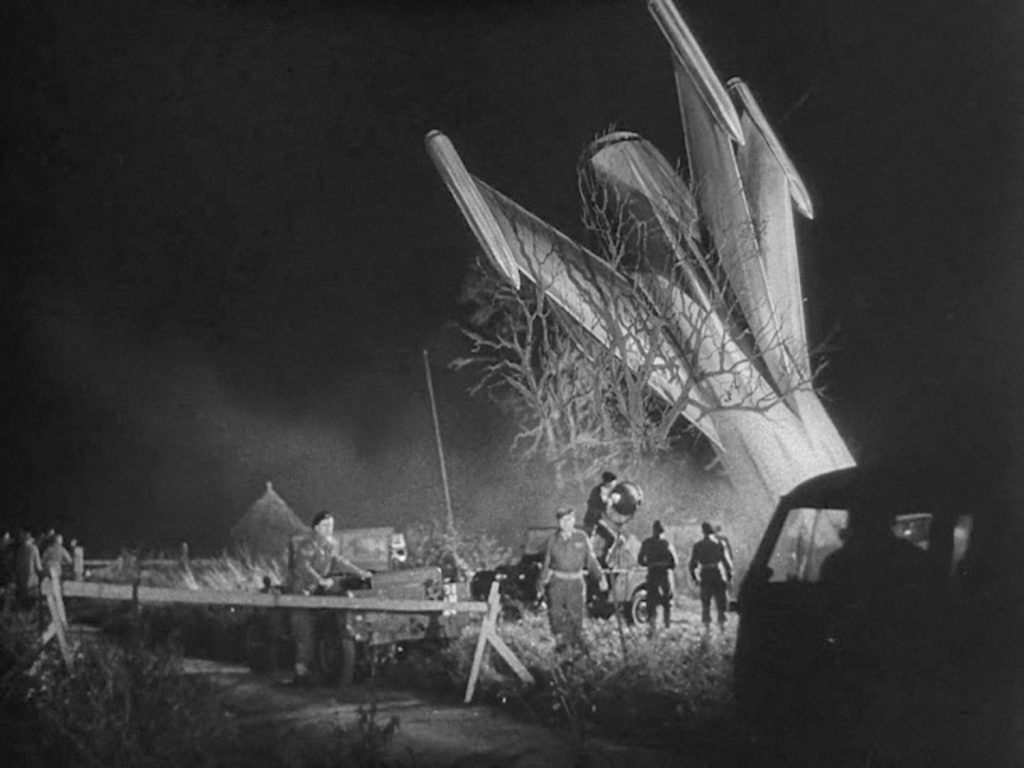
This is the crash site of the first manned rocket launched into space by scientist Bernard Quatermass’ group. After losing contact with the rocket and its three-man crew, the craft was found to have subsequently crashed in a field in the English countryside.
Working with a decidedly modest budget, Les Bowie and his special effects team managed some rather effective visuals. Here, everything above the actors’ heads is a Bowie matte painting seamlessly blended with the live-action footage shot on location. A corn field just outside the hamlet of Water Oakley, on the River Thames near Bray Film Studios, served as the crash site. Many Hammer films were shot at Bray Studios during the 1950s and 1960s.
The film was released in the U.S. as The Creeping Unknown.
33) The Valley of Gwangi (1969)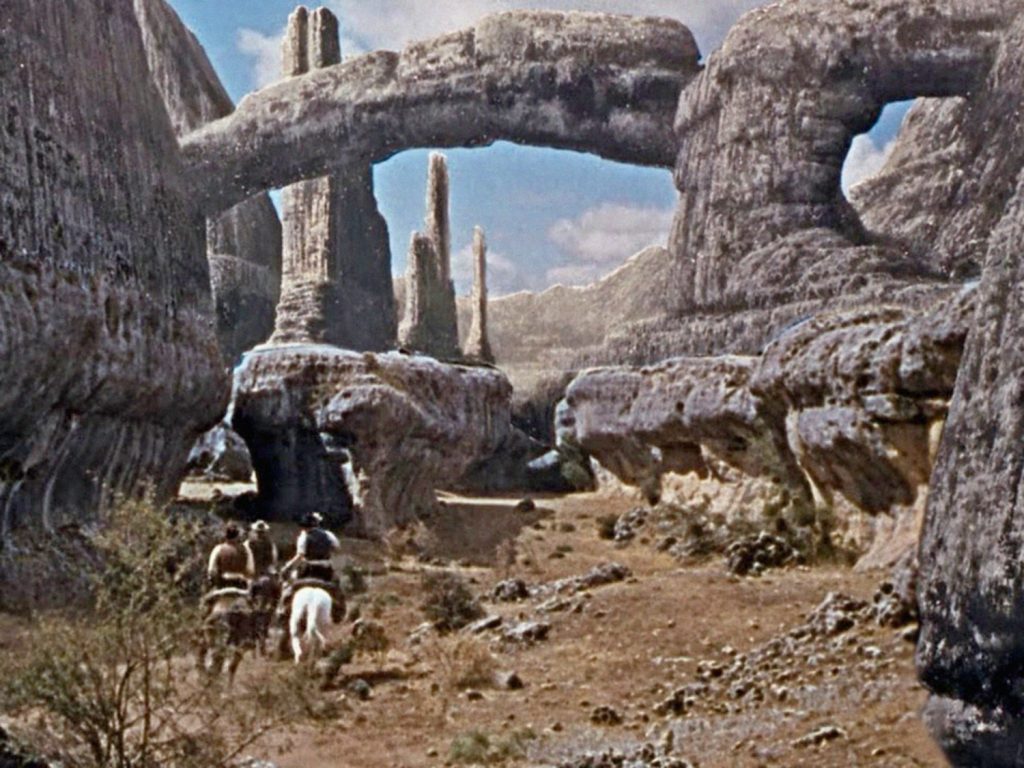
Gerald Larn, a resident matte artist at Shepperton Studios, was the uncredited matte painter who enhanced this Spanish filming location to deliver an introductory view of the Forbidden Valley, into which ride a posse of cowboys who will soon encounter Ray Harryhausen’s animated dinosaurs, most terrifyingly, the allosaurus Gwangi.
34) The Land That Time Forgot (1974)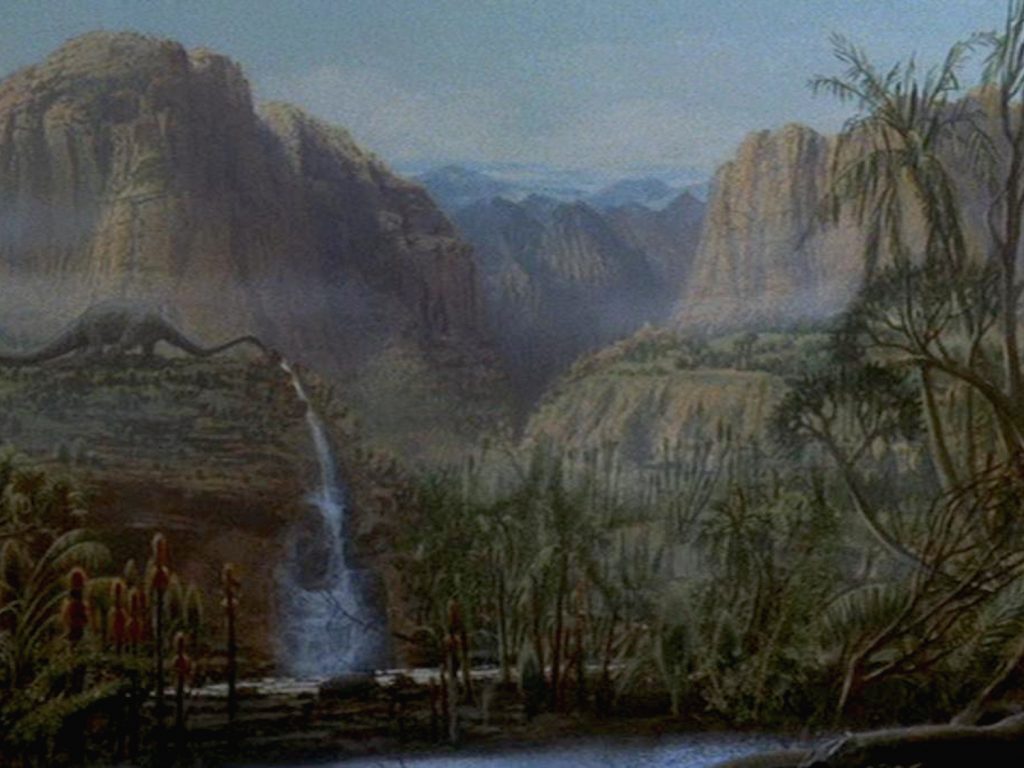
An animated dinosaur drinks from a waterfall in this composite shot of the lush, tropical interior of ice-bound Caprona, a fictional uncharted subcontinent in the South Atlantic, and the setting for this film adaptation of Edgar Rice Burroughs’ novel of the same name.
Credited as supervisor of special effects on the movie, Derek Meddings, famous for his work on Gerry and Sylvia Anderson’s Supermarionation television series, began his career in the 1950s as a matte painter under Les Bowie, rendering many a Transylvanian landscape for Hammer Films productions.
Eschewing stop-motion, the dinosaurs in The Land That Time Forgot were puppets crafted and operated by Roger Dicken.
35) The Monolith Monsters (1957)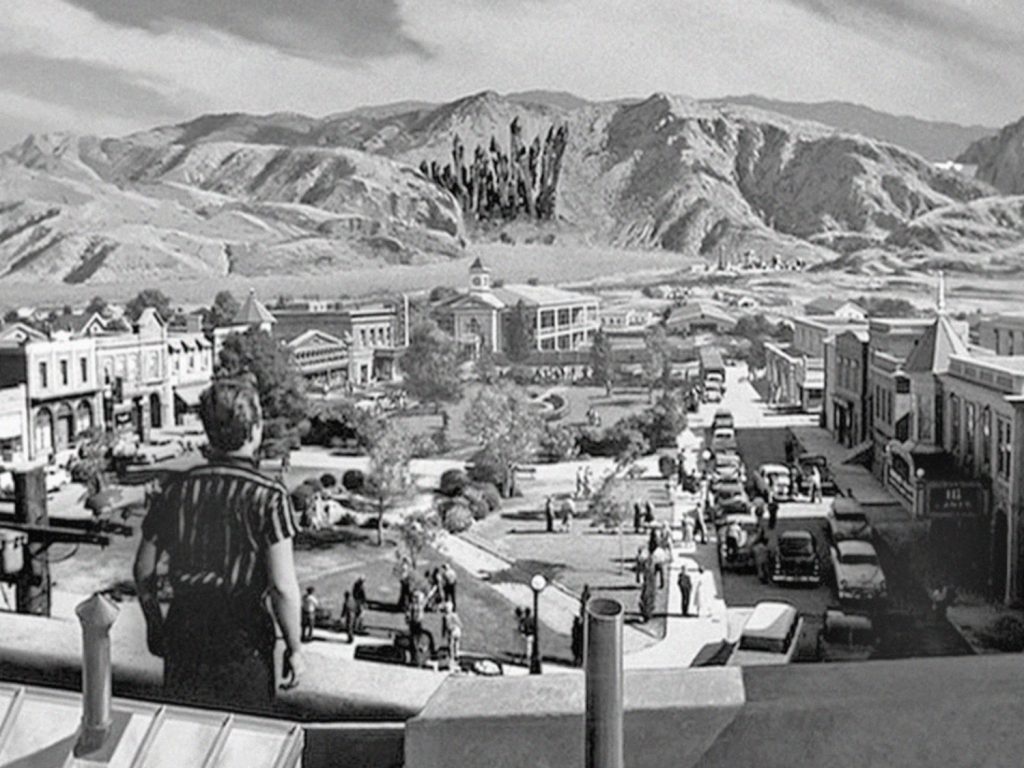
This is the small desert town of San Angelo, California, principal setting of the film. The shot is part real-world location, part matte painting, and part animated monoliths (visible in the distance). Journeyman matte artist Russell “Russ” Lawson, originally of St. John, New Brunswick, worked uncredited on the production.
With water acting as a catalyst, weird rock fragments of extraterrestrial origin grow into towering crystalline spires, then collapse, breaking into numerous pieces, each of which grows again to elevated heights. This ever-expanding rock formation methodically advances across the landscape, threatening the town, and ultimately, all of civilization! And if that wasn’t enough, any person coming in direct contact with these rocks is turned to stone!
This is the surface of Mars, where once flourished an advanced civilization, wiped out long ago in the maelstrom of an atomic war.
On course for the moon, the titular rocketship is unexpectedly hurled towards Mars, where the crew successfully land their spacecraft and begin exploring the Red Planet.
Irving Block was the matte artist on the film. While a black-and-white movie, a red-orange tint was applied to the Mars sequences.
10) THANK YOU!
We thank Keith Braithwaite and Cathy Palmer-Lister for putting this Relax-a-ZOOM together, and offer a nod of appreciation, as well, to all of our supporting contributors. And of course, we thank all who attended virtually today.
MonSFFA hopes you have enjoyed your time with us this afternoon, and we ask all of you to check in regularly here at www.MonSFFA.ca for additional content.
We look forward to again gathering, face to face, at August’s get-together, the first in-person meeting we’ve been able to schedule in over three years! Check back with us regularly in the weeks upcoming for more information on the August meeting.
Thank you for your interest and attention today, and don’t forget to comment on this afternoon’s e-gathering!
11) SIGN-OFF
Until we meet again, stay safe, keep healthy, and continue to enjoy your summer!
July 2023 Relax-a-ZOOM, Post 3 of 4: Break; Club Business, Lobby Card Game
 For the first time in over three years, MonSFFA will be hosting a live, in-person meeting! It’s scheduled for next month!
For the first time in over three years, MonSFFA will be hosting a live, in-person meeting! It’s scheduled for next month!
When the COVID-19 pandemic was declared, we shut down our meeting schedule in keeping with safety protocols implemented at the time. We fully expected to return to a meeting hall in a few weeks, couple months, at most.
-sigh-
Much has changed in the intervening years. The club remained active, but online, quickly introducing a virtual meeting schedule, which developed to include a ZOOM-Chat component in parallel with posted material. This sustained us through the darkest days of the pandemic—remember those lockdowns and curfews!
We find ourselves, now, finally, able to host in-person meetings again after some two years of frustration talking with hotels that had jacked their prices to stratospheric heights way beyond reasonable, or simply shut down their function space altogether. Post-pandemic nerves kept many churches, schools, public libraries, and community centers either reluctant to accommodate us, or just plain unable, or unwilling to make room for us!
 But we recently found a very inviting locale, and we’re excited to tell you all about it, and answer your questions about the when, where, and what about this and that! Our ZOOM-Chat for the next little while, therefore, will focus on this new development, and a few other matters related to the club’s activities.
But we recently found a very inviting locale, and we’re excited to tell you all about it, and answer your questions about the when, where, and what about this and that! Our ZOOM-Chat for the next little while, therefore, will focus on this new development, and a few other matters related to the club’s activities.
MonSFFA Executive member Joe Aspler snapped the photos below of the facilities we expect to make our new home. There’s plenty of room for a meeting, and for large-scale events like a book sale, and there’s even a bar!
So, a quick overview of all this, and then we’ll field your questions.

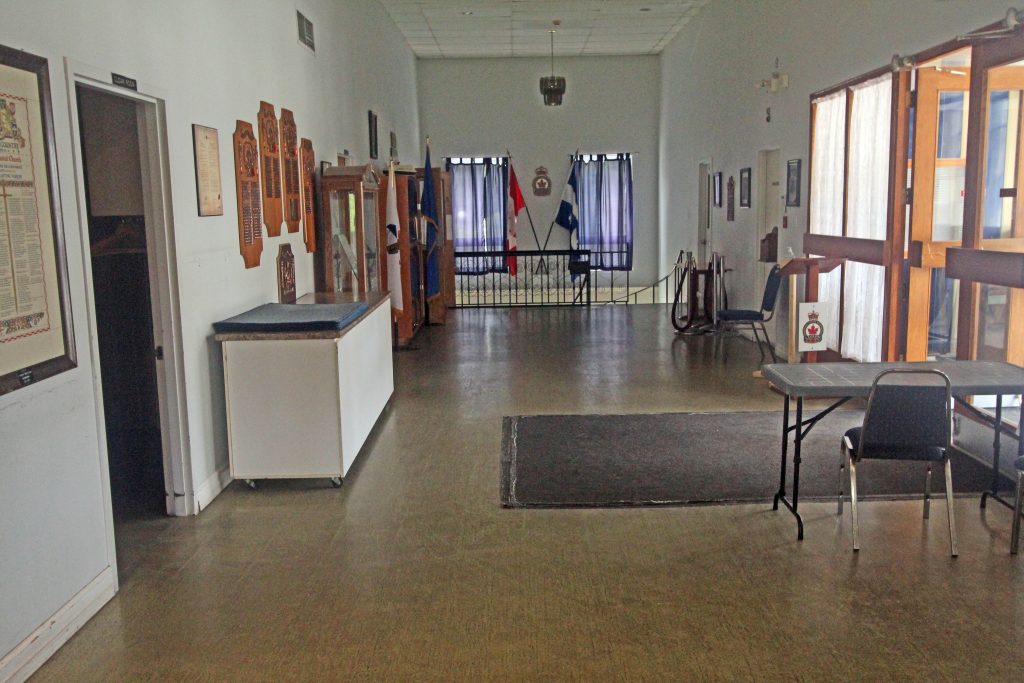




July 2023 Relax-a-ZOOM, Post 2 of 4: 7 Stupid SF/F Shark Movies (Rerun), Chat Continues…
Our ZOOM-chat continues, but with a marked increase in shark attacks in the news this summer, we thought we’d rerun the following post, which was originally part of our November 2022 online meeting.
Steven Spielberg terrorized beach-goers in the summer of 1975 and initiated the modern age of cinematic blockbusters. His Jaws remains the epitome of shark movies. It has many imitators—The Reef, The Shallows—but no equals.
Some shark films, like Deep Blue Sea and The Meg, added science fictional elements to the formula and independent, low-budget, straight-to-video filmmakers soon dove into those lucrative waters, with mixed results.
Some adopted the idea of purposely producing so-bad-it’s-good fare as comically wacky entertainment, resulting in Sharktopus, Dinoshark, Sharknado, and other examples of brainless, B-movie, sci-fi/shark movies. The best of these basked in their absurdity and played as tongue-in-cheek homages to both the shark-adventure and science fiction genres.
At the bottom of the chum bucket are found the irredeemably botched SF/F shark movies, truly the worst, most unprofessional, hackneyed, nonsensical, substandard, misguided failures. Highlighted below are titles that we judged largely as such. Your mileage may differ.
Sharkenstein (2016)
A way-out, wild sci-fi/horror mélange of Jaws, Nazispoitation, and Frankenstein, Mark Polonia directs this earnest but unsatisfactorily executed movie, featuring a cast that includes at least a couple of moderately capable independent-film actors boasting a number of genuine credits within the low-budget horror genre.
The story involves a mad scientist’s scheme—the Great Experiment—to create from the body parts of Great Whites, Hammerheads, Makos and other man-eaters, the penultimate killer shark, into which will be surgically implanted the undying heart and brain of Frankenstein’s monster!
Having originated during World War II, the plan finally comes to fruition in present-day USA. Arriving in a small coastal town for a day of boating, three friends, Skip, Coop, and Madge, soon become entangled in the scientist’s dastardly plans.
While the writing and, in particular, special effects utterly fail to live up to the production’s central, high-concept idea, I’ll give the principal players kudos for, once or twice, expressing through their performances a knowing nod to the fatuous genre within which they are working.
At one point, Greta Volkova, starring as Madge, delivers a line of awkwardly scripted foreshadowing with the mock gravitas appropriate to the occasion. “I’ve never seen a shark like that before,” she emotes. “It looked like a grotesque combination of different sharks.” She later pays nerdy, loving tribute to the Frankenstein story, rattling off a list of classic Frankenstein films produced by Universal and Hammer.

And Jeff Kirkendall, affecting a clichéd German accent as the mad scientist, crowingly outlines his outrageous plan in detail for our three heroes, who find themselves his captives at one point. He and other neo-Nazis operating clandestinely across the globe intend to deploy an “indestructible and unstoppable” army of supersharks, beginning with the archetypal “Sharkenstein.” Eventually, the preserved brains of Nazi leaders, including Hitler himself, will be transferred into these abominations, thus triggering another World War, which this time, the Nazis will win! After a few silent beats to allow the horrendous enormity of the plan to sink in, he melodramatically intones, “This is the part where you tell me I’m crazy!”
All fun, if decidedly imperfect, stuff, in the spirit of the genre, marred further by the clumsiest possible compositing of a Sharkenstein puppet and blood-splatter with live action footage!
Planet of the Sharks (2016) and Empire of the Sharks (2017)

The Asylum, an independent film production house specializing in low-budget, straight-to-video projects, is the chief purveyor of “sharksploitation” flicks like these two. Both are from director Mark Atkins, Empire a prequel to Planet.
Set in a dystopian, Waterworld-like near-future in which global warming has caused the Earth’s glacial ice to melt, flooding the world, pockets of humanity survive on small floating islands of barges, wharves, and boats tethered together.

With ocean plankton unable to endure the warming waters, the ocean’s food chain is collapsing and almost all sea life is dying off, leaving only a great school of sharks, led by an alpha female. But with no fish to eat, the ocean’s apex predators must hunt for food above the surface. “And that’s us,” explains Planet of the Sharks’ Dr. Shayne Nichols, a scientist who is working with others to launch a rocket equipped with CO2 scrubbers into the high atmosphere, and so reverse the effects of climate change and lower sea levels. Yeah, that’ll work!
But first, an electronic gizmo must be dropped into a dormant undersea volcano in order to draw the threatening sharks to their doom when the team open fire with a laser, which will trigger an eruption. Or something.

There’s a lot of tedious, unnecessary detail, here, which causes the story to drag. And between brief and uninspiringly shot scenes of unconvincing CGI sharks leaping out of the water to chomp on people, far too much of the film’s runtime is spent on lengthy sequences of expository dialogue among the protagonists, just standing around talking to each other. There are also a number of completely superfluous characters, who contribute little, if anything, to the story, save only to further pad out the film’s runtime.


Empire of the Sharks is saddled with many of the same flaws, presenting audiences with countless interminable shots of characters staring intently or woefully at off-screen goings-on, or skimming about on various watercraft, or manoeuvering underwater with Sea Scooters, or aboard a submersible.
Something of a Mad Max on the water, the action, such as it is, follows a poorly realized young hero, who sets out to rescue his girlfriend, Willow, taken captive in the first reel by a ruling overlord. Martial law is imposed by way of a legion of sharks, which the antagonists control with what looks somewhat like a pair of gloves pilfered from the Rollerball set and wrapped in a string of Christmas lights. Each of this post-apocalyptic world’s small, floating communities are required to pay a regular tribute to the strongman, with ruthless punishment meted out to any who refuse, or defy him. Transgressors are held prisoner on his floating fortress and forced into slave labour, with those marked for execution tied to a float and fed to the ravenous sharks.

Long story short, our hero assembles a crew of mercenary types to help rescue the girl and overthrow the evil empire. She, meanwhile, possessed of an innate psychic ability, channels her powers to challenge the overlord for control of sharks, managing to turn them against him and helping to win the day. Like her father before her, she is a “shark caller,” and is celebrated as such as the film concludes.
A handful of the actors, at least, cast in these films have as much fun with their roles as dull scripting will allow, most notably Empire’s Jonathan Pienaar, who plays the overlord’s right-hand man with over-the-top, villainous relish.
Nary a farcical wink is offered to the inherent cheesiness of either movie, and so, these pictures are nothing more than pedestrian sci-fi/actioners. So if you like nonsensically bad science fiction films, you’ll have a better time with The Asylum’s hit, Sharknado, which fully embraces and lampoons the flavour of sci-fi B-movies and its own outlandish premise.
Ouija Shark (2020)
One would not be exceedingly surprised to discover that this movie was produced by a sixth-grader equipped with dad’s camcorder and I suppose that Ottawa-based actor/writer/director Brett Kelly was, once, some years ago, in the sixth grade. Kelly, who guested at ConCept in 2006, directs, here, under his Scott Patrick pseudonym.
Reportedly made for some $300, most of that budget apparently allocated to the titular shark, a rubber, dollar store-quality toy, one cannot reasonably expect very much, if anything, of this film.
A group of girls enjoying a backyard pool party decide to experiment with an old Ouija board that one of them found washed up on a nearby beach. Inadvertently, they conjure up the ghost of a Great White Shark, which appears as a glowing spectre unremarkably superimposed into various scenes as, one after another, each of the girls is attacked by this phantom fish.
The cast are high-school-drama-club amateurish, a few especially so, the pacing often lethargic, and the production values carelessly inferior. But these factors, coupled with the sheer idiocy of the whole affair, might have been forgiven had the writers injected moments of self-aware pretense. Alas, we are offered but a few weak barbs, not nearly enough of a boost to elevate the piece whatsoever.
Kelly has produced better stuff under his actual name; this one is to be avoided.
Land Shark (2020); Original Title: Lù Xing Shā
Candygram.
The English title of this movie suggests a feature-film adaptation of that classic Saturday Night Live skit, but this is, in fact, a Chinese creature-feature budgeted at some $2 million. Rather derivative of such fare as Deep Blue Sea, The Meg, Tremors, and any number of kaiju films—there’s even a Free Willy moment included!—director Cheng Si-Yu helmed what proved to be a pretty standard-issue CGI-monster movie, reasonably well-crafted but tarnished by a daft premise.
A pharmaceutical research laboratory’s attempt to engineer an anti-cancer drug via genetic tampering results in the creation of a giant, beastly shark capable of terrorizing mankind in the water, and on land!
All of the stereotypical characters that populate such genre films are present, here: the take-charge hero, shark wrangler Song Yi, and his goofy friend and sidekick, Pang Yu, responsible for comic relief; the greedy, callous corporate executive behind the experiment, Qian Cheng; the noble scientist, young, pretty Ye Xin, also our hero’s romantic interest; her craven, morally bankrupt colleague; the leader of Cheng’s private militia, who begins to question his boss’ ethics; the cute kid; and a gaggle of others who serve as chum.
Early in the narrative, the lab’s team of scientists and technicians are surprised to discover that their test subject, an aggressive male shark, is pregnant, an incomprehensible turn of events. “Could it be possible,” asks the portly Pang Yu, “that the shark is so depressed because of being locked up, that it became a sissy as a result?”
I watched the English dub of the film, so I’ll allow that something may have been lost in the translation, however, such puerile dialogue did not bode well.
Later, it’s learned that the shark’s genetic material was augmented by that of earthworms, which reproduce asexually. This, apparently, explains the shark’s pregnant state, and its ability to move about on land and burrow through the soil in hot pursuit of the panicked laboratory personnel! There’s a lot of frantic running away, willy-nilly, until in a moment of respite, we hear again from Pang Yu, who unintentionally summarizes the entire movie. “What’s this even about?” he gasps, breathless. “The sea creature that swims on land! This is quite unscientific.”
Indeed.
Not to be taken seriously as the straight-up science fiction/action picture it aspires to be, but that said, Land Shark does have its charms.
Shark Side of the Moon (2022)
Another one from The Asylum, this stultifyingly lame sci-fi effort, is part Jaws, part Iron Sky, all stupid!
Shark Side of the Moon is a so-called “Mockbuster,” that is, a cheap and cheesy movie that capitalizes on the recognition and popularity of one or more critically-acclaimed and/or big-budget box office successes, often blatantly filching elements from the mainstream films that served as inspiration. Sometimes, this results in a charmingly silly, funny, entertaining, tongue-firmly-in-cheek, in-joke homage of sorts.
But not in this case. Not at all. Even remotely.
The title suggests an astonishingly ridiculous premise, and indeed, Shark Side of the Moon, released as a “Tubi Original” and part of the low-rent streaming service’s Bitefest, involves a colony of deadly human/shark hybrids who have established a technologically advanced colony on the moon!

Created by Soviet scientists during the Cold War, these creatures quickly escaped, but before they could wreak havoc, were lured aboard a space shuttle by one of the scientists for a one-way flight to the moon. Forty years later, American astronauts returning to the moon soon encounter these lunar shark-men, as well as the scientist—he remained aboard the shuttle as pilot—and his half-human, half-shark daughter!
The acting is shoddy and melodramatic, the dialogue inane, and the direction and editing lacklustre, with only the occasional visual effect offering a modicum of flair.
And I won’t even bother to address the film’s unforgivable misunderstanding of basic science, the dubious logic of proceedings, or the sagacity of characters’ motivations because, clearly, the screenwriters didn’t seem to think any of that particularly important, either!
Sharkula (2022)
Director Mark Polonia seems to revel in cut-rate sharksploitation projects; he tapped into the Frankenstein mythos in 2016 (see above) and here returns with a bat-shit crazy Dracula-inspired shark movie!
Set in present-day New England, in the coastal town of Arkham—a salute to Lovecraft—the story began centuries earlier. Count Dracula is chased by a “makeshift mob of uneducated farmers” to the edge of a cliff overlooking the sea, where he is stabbed. Wounded, he falls into the raging surf below and is immediately attacked by a large, blood-lusting shark. By way of “mind control,” however, the King of the Vampires succeeds in communicating with, and transferring to the shark his curse.
“If I served him, he would protect me,” Dracula explains later, as he recounts the tale to Arthur and Mina, two of the film’s leads, all of whom are named for characters in Stoker’s original novel. “We all serve someone, or something. Even the mighty Dracula!” he continues. “As those who serve me, I must serve it.”
“Sounds like a load of crap!” replies Arthur.
Precisely.
And the crap doesn’t come any more coiled and steaming than in this movie.


The writing is atrociously bad and the acting underwhelming, though a couple of cast members do strive desperately to make something more interesting of the material they’ve been given. Meanwhile, for some reason—maybe to put across a weird, cultish vibe but more likely to extend the film’s runtime—director Polonia returns often to non-sequitur shots of a leather-clad woman dancing on a beach at dusk twirling what look like flaming marshmallows on sticks!
There is really only one worthwhile thing to be found in this flick: a catchy, 1960s-style, surf-guitar piece by the Sea Demons, employed as Sharkula’s theme song.
Listen here:
Conclusion:
If you like your science fiction, horror, and shark movies cheap, cheesy, and stupid, drop your line in these waters!
All kidding aside, it’s easy to slam such efforts and poke fun, but even the most egregious examples often include a spark or two of creativity that, given more talent and money, may well have amounted to something.
July 2023 Relax-a-ZOOM, Post 1 of 4: Introduction, SF/F Geography Quiz, Chat Begins
 1) INTRODUCTION
1) INTRODUCTION
Missed MonSFFA’s Barbecue-in-the-Park last Saturday? The club is hosting today online a “Relax-a-ZOOM” Virtual Picnic! Have your favourite summer snacks and libations on hand!
 No formal programming is planned, just a game or two, and an afternoon of casual conversation with friends on topics SF/F and fannish! Share with your fellow MonSFFen the details of your latest genre-themed craft project, tell the group about an SF/F book, movie, or TV series you’ve been enjoying of late, or share vacation photos of cool sci-fi events, exhibits, museums, or shops you may have recently visited? The floor is open! Your input is welcome and encouraged!
No formal programming is planned, just a game or two, and an afternoon of casual conversation with friends on topics SF/F and fannish! Share with your fellow MonSFFen the details of your latest genre-themed craft project, tell the group about an SF/F book, movie, or TV series you’ve been enjoying of late, or share vacation photos of cool sci-fi events, exhibits, museums, or shops you may have recently visited? The floor is open! Your input is welcome and encouraged!
Also, given this opportunity, we will have information on our scheduled August in-person meeting—the first in over three years!—plans for the return of the club’s fund-raising book sale, and other matters for which the input of our membership is desired.
So let’s get started…
2) JOIN THIS AFTERNOON’S VIDEO-CHAT ON ZOOM!
To join our ZOOM video-chat, which will run throughout the next few hours, simply click here and follow the prompts: This Afternoon’s MonSFFA e-Meeting on ZOOM
If you’re not fully equipped to ZOOM, you can also take part by phone (voice only); in the Montreal area, the toll-free number to call is: 1-438-809-7799. From out of town? No problem; find your ZOOM call-in number here: Call-In Numbers
Also, have this information on hand as you may be asked to enter it:
Meeting ID: 892 8664 2629
Passcode: 673323
3) TODAY’S AGENDA
Post 1 of 4, 1:00PM—Introduction, SF/F Geography Quiz, ZOOM-Chat Begins
Post 2 of 4, 2:00PM—ZOOM-Chat Continues, 7 Stupid SF/F Shark Movies (Rerun)
Post 3 of 4, 3:00PM—Mid-Meeting Break; Discussion of Club Business, With Special Focus on August 17 In-Person Meeting, Lobby Card Game
Post 4 of 4, 4:00PM—Answers to SF/F Geography Quiz and Wrap-Up
4) SF/F GEOGRAPHY QUIZ
How well do you know your science fiction and fantasy geography?
Culled from SF/F cinema and television, we have selected 36 images depicting a variety of landscapes, from strange alien worlds and futuristic cities to legendary lands and foreboding architecture, each a setting featured in a different science fiction or fantasy movie or TV series.
These images are what filmmakers term “establishing shots.” Whether real-world locations, miniature sets, glass or matte paintings, or a composite of several elements seamlessly stitched together by Hollywood’s special effects wizards, an establishing shot is employed to visually place the audience in a particular setting ahead of the action that is about to unfold.
Your challenge is to identify the film or TV series that corresponds to each image. Give yourself an additional pat on the back if you can name or describe the geographical location in question!
Good luck!
Panoramas
Standard Frame
July 2023 Relax-a-ZOOM Virtual Picnic is Today!
Relax-a-ZOOM Virtual Picnic is this Saturday!
Relax-a-ZOOM Virtual Picnic
Missed MonSFFA’s Barbecue-in-the-Park last Saturday? The club will host a “Relax-a-ZOOM” Virtual Picnic right here at www.MonSFFA.ca this Saturday, July 15, beginning at 1:00PM! Have your favourite summer snacks and libations on hand!
No formal programming is planned, just a game or two, and an afternoon of casual conversation with friends on topics SF/F and fannish! Share with your fellow MonSFFen the details of your latest genre-themed craft project; tell the group about an SF/F book, movie, or TV series you’ve been enjoying of late; or share vacation photos of cool sci-fi events, exhibits, museums, or shops you may have recently visited!
The floor is open! Your input is welcome and encouraged!
Given this opportunity, we will have information on our scheduled August in-person meeting—the first in over three years!—plans for the return of the club’s fund-raising book sale, and other matters for which the input of our membership is desired.
Mark your calendars, and we hope to see you online Saturday!
REMINDER: CLUB BBQ THIS SATURDAY, RELAX-A-ZOOM NEXT SATURDAY!
We remind MonSFFen to mark the next two Saturdays on their calendars!
MonSFFA’s Summer Barbecue-in-the-Park 2023 is scheduled for this Saturday, July 8, and our virtual get-together/picnic—a “Relax-a-ZOOM”—is set to follow one week later, on Saturday, July 15.
Barbecue-in-the-Park
MonSFFen and their families, as well as friends of the club, are invited to gather beginning at 10:00AM in Parc Maisonneuve on Saturday, July 8, for the club’s 2023 Barabecue-in-the-Park! Parc Maisonneuve, easily accessible by Metro or bus, is located in the city’s East End, adjacent the Botanical Gardens and the Olympic Stadium. Parking is available on site, or on nearby streets.
Our intention is to claim a picnic spot somewhere along one of the rows of trees, not too far from the parking lot and the chalet. Our “Preferred Picnic Area” is indicated on the map (above). Look for us in roughly that area.

So join us for a relaxing day in the park! Friends, fun, food, and fire, the latter in the form of our new “Dragon’s Breath” propane barbecue, which we’ll have on site for those who may wish to grill up a couple of hamburgers, hotdogs, and other such summer staples! Bring your own refreshments, snacks, and any meats you may wish to barbecue.
And please note that proper washroom facilities are located in the chalet, a marked improvement over the deteriorating and unsanitary facilities at Parc Angrignon, our former barbecue locale!
Should the weather prove inclement on the 8th, the event will be shifted 24 hours forward to Sunday, July 9. If necessary, we will post a notice on the club’s Website of any change in the schedule by no later than 9:00AM, Saturday morning, the 8th.
Then…
SATURDAY, JULY 15, 1:00PM: Relax-a-ZOOM Virtual Picnic
We will also host, this month, a “Relax-a-ZOOM” Virtual Picnic right here at www.MonSFFA.ca on Saturday, July 15, at 1:00PM—have your favourite summer snacks and libations on hand!
No formal programming is planned, just a game or two, and an afternoon of casual conversation with friends on topics SF/F and fannish, including, given this opportunity, a little bit of club business regarding our planned August in-person meeting, and related issues, for which the input of our membership is desired.
We hope to see you at one, or both of these events!
To download a PDF of our “Club Events in July” flyer, click here: FLYER
CLUB EVENTS FOR JULY!
Mark the next two Saturday’s on your calendars! MonSFFA’s Summer Barbecue-in-the-Park 2023 is scheduled for this Saturday, July 8, with a virtual get-together/picnic, our Relax-a-ZOOM, to follow one week later on Saturday, July 15.
Barbecue-in-the-Park
MonSFFen and their families, as well as friends of the club, are invited to gather at 10:00AM in Parc Maisonneuve on Saturday, July 8, for the club’s 2023 Barabecue-in-the-Park! Parc Maisonneuve, easily accessible by Metro or bus, is located in the city’s East End, adjacent the Botanical Gardens and the Olympic Stadium. Parking is available on site, or on nearby streets.
Our intention is to claim a picnic spot somewhere along one of the lines of trees, not too far from the parking lot and the chalet. Our “Preferred Picnic Area” is indicated on the map (above). Look for us in roughly that area.
So do join us for a relaxing day in the park! Friends, fun, food, and fire, the latter in the form of our new “Dragon’s Breath” propane barbecue, which we’ll have on site for those who may wish to grill up a couple of hamburgers, hotdogs, and such! Bring your own refreshments, snacks, and any meats you may wish to barbecue. And note that proper washroom facilities are located in the chalet.
Should the weather prove inclement on the 8th, the event will be shifted 24 hours forward to Sunday, July 9. We will post a notice of any change in the schedule no later than 9:00AM, Saturday morning, the 8th.
Then…
Relax-a-ZOOM Virtual Picnic
We will also host a “Relax-a-ZOOM” Virtual Picnic right here at www.MonSFFA.ca on Saturday, July 15, at 1:00PM—have your favourite summer snacks and libations on hand!
No formal programming is planned, just a game or two, and an afternoon of casual conversation with friends on topics SF/F and fannish, including, given this opportunity, a little bit of club business regarding our planned August in-person meeting, and related issues, for which the input of our membership is desired.
June 2023 Virtual Meeting; Post 7 of 7, 4:30PM: Answers to Trivia Quiz and Wrap-Up
 This is our closing post of the afternoon.
This is our closing post of the afternoon.
11) ANSWERS: TWO-FOUR SCI-FI TRIVIA QUIZ
 Following are the answers to the trivia quiz we posted at 1:00PM. How many questions did you correctly answer? Compare your answers to these:
Following are the answers to the trivia quiz we posted at 1:00PM. How many questions did you correctly answer? Compare your answers to these:
1) Fill in the blank! These SF/F titles are missing a single word: The ______ Tree; Haunted______; Dinosaur ______; and Without a ______. What is that missing word?
ANSWER: “Summer” is the missing word.
The Summer Tree (1984) is a novel by Canadian fantasy writer Guy Gavriel Kay, Book One of his Fionavar Tapestry.
Haunted Summer (1988) is a film dramatizing the famous summer of 1816 at Villa Diodati near Lake Geneva, Switzerland. Romantic poet Lord Byron had rented the house and invited a group of his aristocratic friends to join him there. During their stay, a horror-story writing contest was organized, spawning two classics of Gothic literature, John William Polidori’s “The Vampyre” and Mary Wollstonecroft Shelley’s (née Godwin) Frankenstein; or, the Modern Prometheus. Polidori’s story is cited as the originator of romantic vampire fiction, Shelley’s often as the first true science fiction story.
Dinosaur Summer (1998) is an alternate-history novel penned by Greg Bear. It’s 1947 in a world where the dinosaur-populated South American plateau of Conan Doyle’s The Lost World (1912) is an actual place, and his Professor Challenger a real person! Among the central group of characters are versions of real-life fantasy filmmakers Willis O’Brien and Ray Harryhausen, whose lives take a different turn in a reality where the existence of the real thing rendered unnecessary animated rubber models of dinosaurs.
Without a Summer (2013), a novel by Mary Robinette Kowal, is Book Three of her Glamourist Histories series, which injects an element of magic—here called “glamour”—into historical romantic fiction. The title refers to the so-called “Year Without a Summer,” 1816, the same period in which is set Haunted Summer. A volcanic eruption in the Pacific the previous year triggered a global climate anomaly and a decrease in normal temperatures, resulting in a chilly, rainy summer in Europe and food shortages across the Northern Hemisphere.
2) First seen in the opening minutes of Star Wars (1977), what is the name of this CR90 corvette, employed as an Alderaanian diplomatic cruiser and rebel blockade runner?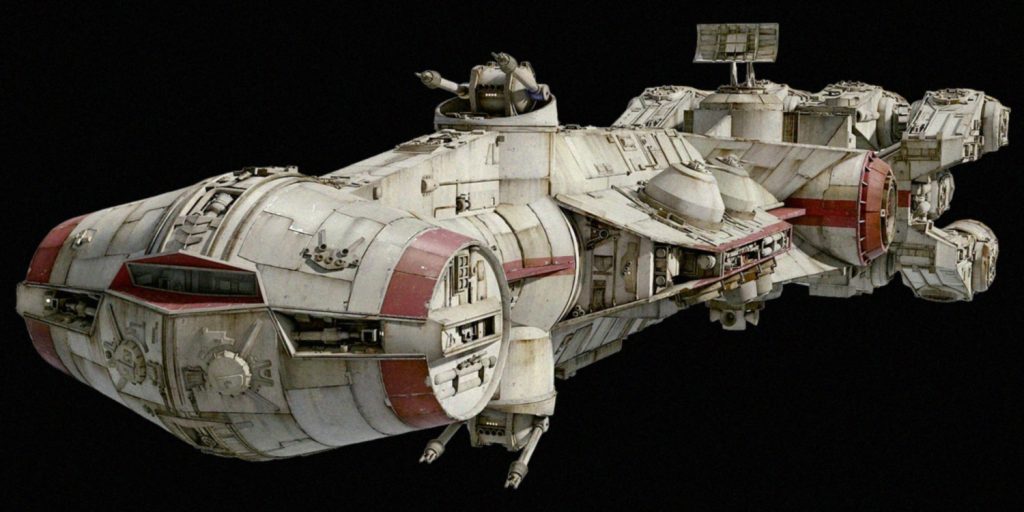
ANSWER: Tantive IV.
3) Which of these characters does not belong? A) Jaime Reyes, B) Samuel “Sam” Guthrie, C) Dan Garrett, D) Theodore “Ted” Kord
ANSWER: B) Samuel “Sam” Guthrie, alter ego of the Marvel superhero Cannonball, a founding member of the New Mutants.
The other three have this in common: each has donned the mantle of the superhero Blue Beetle. Garrett (spelled “Garret” initially) was the original Golden Age character (1939, Fox Comics; later Charlton Comics, where the character was refurbished for the Silver Age). Kord followed (Charlton Comics, and eventually DC Comics), and finally, Reyes (DC Comics). Reimagined and retconned over the decades, Blue Beetle has usually been depicted as deriving his superpowers from an ancient mystical Egyptian scarab, most recently interpreted as a technologically advanced device of alien origin.
A Warner Bros./DC film adaptation of the Reyes Blue Beetle is scheduled to premiere August 18 of this year.
4) Most Worldcons have been held in the U.S.; how many have been held outside of the United States?
ANSWER: There have been 80 Worldcons held to date. Excluding CoNZealand in 2020, which was moved online for reasons of pandemic-related safety, 21 have been held outside the U.S.
The U.K. has hosted seven, five in England, two in Scotland; Canada has hosted five, Australia four, and Germany, the Netherlands, Japan, Finland, and Ireland, one each.
The 81st Worldcon will take place in Chengdu, China later this year, and Glasgow, Scotland will again host in 2024, which will boost the number of non-U.S. Worldcons to 23.
5) Who played youngster David MacLean in the original Invaders From Mars (1953), in which the vanguard of a Martian invasion force lands in the boy’s hometown?
ANSWER: Jimmy Hunt. Decades later, an adult Hunt appeared as the town’s police chief in Tobe Hooper’s 1986 remake of Invaders From Mars.
6) The novels Omnivore (1968), Orn (1970), and OX (1976) constitute which SF trilogy?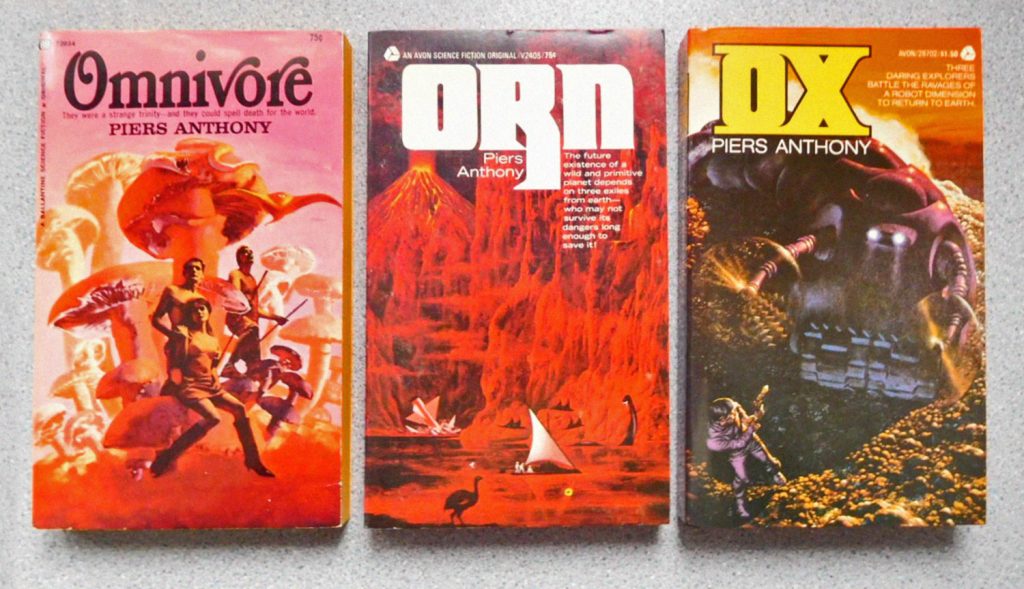
ANSWER: Of Man and Manta.
All three novels were collected as Of Man and Manta (1986). Explorers from Earth investigate a world populated by fungi, including the intelligent mantas, which superficially resemble manta rays.
7) What is the title of the fifth Indiana Jones movie, scheduled to premiere later this month, on the 30th?
ANSWER: Indiana Jones and the Dial of Destiny (2023).
8) “They Were Looking For Chicks…To Go All The Way!”—the marketing campaign of which sci-fi movie employed that tag line? A) Teenagers from Outer Space (1959), B) Mars Needs Women (1968), C) Earth Girls Are Easy (1988), D) Invasion of the Saucer-Men (1957)
ANSWER: B) Mars Needs Women (1968), written, produced, and directed by self-proclaimed schlock artist Larry Buchanan. Disney mainstay Tommy Kirk starred, along with Yvonne “Batgirl” Craig.
9) How many Worldcons has Canada hosted?
ANSWER: Five; three in Toronto (1948, 1973, and 2003), one in Winnipeg (1994), and one in Montreal (2009).
10) The Humanx Commonwealth, an organization similar to Star Trek’s Federation of Planets, is featured in the science fiction stories of which writer?
ANSWER: Alan Dean Foster.
11) What two sentient species jointly administer the Humanx Commonwealth?
ANSWER: the mammalian Humans, of Earth, and the insectoid Thranx, of Hivehom are the Commonwealth’s two principal players. Alan Dean Foster’s Nor Crystal Tears (1982), a first-contact story, sees the beginnings of what would eventually become the Humanx Commonwealth, that tale detailed in the author’s Founding of the Commonwealth trilogy, comprising Phylogenesis (1999), Dirge (2000), and Diuturnity’s Dawn (2002).
12) Which of these men develops psychohistory, a fictional algorithmic science that allows general predictions to be made of the future in Isaac Asimov’s Foundation series? A) Harrison Bergeron, B) Harry Harrison, C) Harry Mudd, D) Hari Seldon
ANSWER: D) Hari Seldon.
A mathematics professor at Streeling University on the planet Trantor, Seldon employs sociology, history, and the laws of statistics as applied to large populations in order to arrive at general forecasts of future events. He is thus able to predict the inevitable fall of the Galactic Empire, of which he is a citizen.
Harrison Bergeron is the titular character in a Kurt Vonnegut, Jr. short story, Harry Mudd is a Star Trek rapscallion, and Harry Harrison is a real-life science fiction writer known for his Stainless Steel Rat and Bill, the Galactic Hero series.
13) Who played Camie Loneozner in the original Star Wars (1977), only to see her scenes excised from the final cut?
ANSWER: British model/actress Koo Stark.
Born Kathleen Norris Stark and known for her roles in a couple of mid-1970s erotic films, she also appeared in The Rocky Horror Picture Show (1975), the sci-fi/romantic comedy Electric Dreams (1984), and a 1989 episode of Red Dwarf.
She was Prince Andrew’s girlfriend for a time, something of a scandal in that she had starred in what the press categorized as soft-core porn films—yeah, she was the degenerate! Stark later became an accomplished photographer.
Her role in Star Wars was as one of Luke Skywalker’s group of friends on Tatooine. Those excised scenes have since become available for ardent fans.
14) Match the robots (left column) with the science fiction titles in which they appear (right column).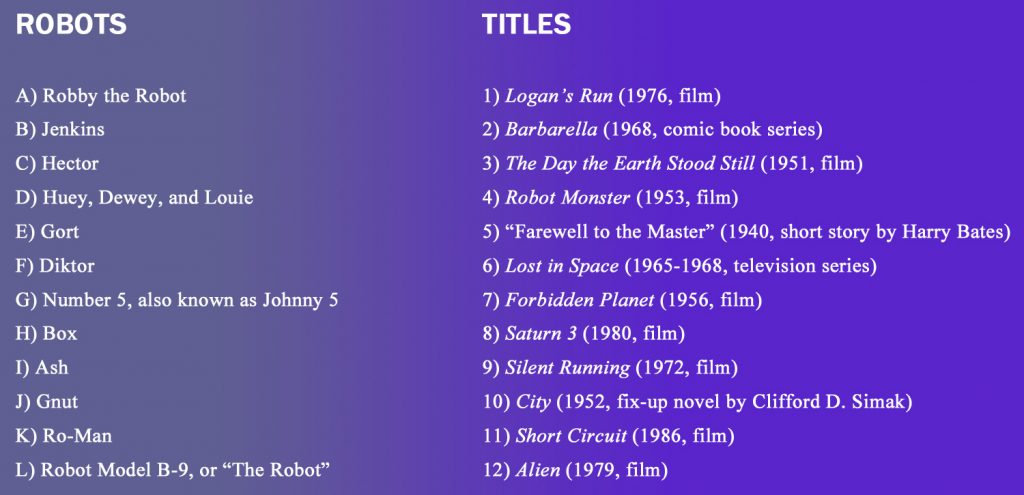
ANSWERS: A-7, Robby the Robot appeared in the classic Forbidden Planet; B-10, robot servant Jenkins attended generations of the Webster family in Clifford D. Simak’s City; C-8, Hector was the homicidal robot in Saturn 3; D-9, Huey, Dewey, and Louie were maintenance drones aboard the Valley Forge in Silent Running; E-3, Police robot Gort appeared in The Day the Earth Stood Still; F-2, Diktor the robot lover appeared in the Barbarella comic books;
G-11, Number 5, later renaming himself Johnny 5, was an experimental military robot that gained sentience after a lightning strike scrambled its programming in the sci-fi/comedy Short Circuit; H-1, Box was a shiny, chrome-plated robot designed to capture food—and runners!—outside the city in Logan’s Run;I-12, Ash was the duplicitous android in Alien; J-5, Gnut was the robot featured in the Harry Bates story that served as the basis for The Day the Earth Stood Still; K-4, Ro-Man was bent on the destruction of Earth in Robot Monster; and L-6, “The Robot” was principally the companion and protector of young Will Robinson in TV’s Lost in Space.

15) Who played astronomer Dr. Stuart Kelston in the original Invaders From Mars (1953)?
ANSWER: Arthur Franz.
16) The protagonists of the science fiction novel Icerigger (1974) crash-land on what frozen world?
Alan Dean Foster’s Icerigger is the first book of a trilogy set on this frigid, windswept planet, inhabited by the cat-like, bipedal Tran, who sport batwing-like menbranes under their arms and specialized claws on their feet with which to windskate across the arctic landscape.

Mission to Moulokin (1979) and The Deluge Drivers (1987) are Icerigger’s two sequels.
17) “Derelict of Space” (1939), “Meteor” (1941), “Tyrant and Slave-Girl on Planet Venus” (1951), and “The Red Stuff” (1951)—who wrote these science fiction short stories?
ANSWER: They were all penned by English SF writer John Wyndham writing as John Beynon. The author of The Day of the Triffids (1951) and The Midwich Cuckoos (1957) derived several pseudonyms from his birth name, John Wyndham Parkes Lucas Beynon Harris; John Wyndham itself is one such alias!

18) Which of these science fiction characters does not belong with the others? A) Ethan Frome Fortune, B) Hellespont du Kane, C) Raymus Antilles, D) Skua September
ANSWER: C) Raymus Antilles. Played by Peter Geddis in the original Star Wars (1977), he was captain of the Tantive IV, and was choked to death by Darth Vader in a memorable early scene from the film.
The others are all characters in Alan Dean Foster’s novel Icerigger (1974).
19) Rudolph Martin, Gary Oldman, Frank Langella, and Nicolas Cage—other than their profession, what do these actors have in common?
ANSWER: They have all played the role of Dracula, Martin in the fifth season premiere of TV’s Buffy the Vampire Slayer, Oldman in the 1992 film Bram Stoker’s Dracula, Langella in the 1979 film Dracula, and Cage in the 2023 film Renfield.

20) With regard to the horror genre, what do the towns of Rockbridge, Midwich, Haddonfield, and Antonio Bay have in common?
ANSWER: They all served as the setting of a John Carpenter film.
Rockbridge was the setting of Christine (1983), Midwich of Carpenter’s remake of Village of the Damned (1995), Haddonfield of Halloween (1978), and Antonio Bay of The Fog (1980).
21) André Morell, Andrew Keir, Brian Donlevy, and John Mills have all played which acclaimed scientist-hero?
ANSWER: Professor Bernard Quatermass, head of the British Experimental Rocket Group—later shortened to British Rocket Group.
Quatermass was the main protagonist in the influential BBC science fiction television serials created by Nigel Kneale, and subsequently adapted as a trio of movies by Hammer Film Productions. Morell and Keir both played the role in Quatermass and the Pit, Morell on television (1958-1959), Keir in the Hammer film version (1967). Donlevy played the scientist-hero in Hammer’s The Quatermass Xperiment (1955) and Quatermass II (1957). And Mills played the character, now retired, in Quatermass (1979), a four-part ITV television series recut later that same year by Euston Films for theatrical release as The Quatermass Conclusion.

22) In which Canadian province is set American International Pictures’ 1976 B-movie The Food of the Gods?
ANSWER: British Columbia.
The film was written and directed by low-budget movie-maker and visual effects artist Bert I. Gordon.
A group of friends travel to a remote island in British Columbia on a hunting trip, where they encounter oversized wasps and rats made gigantic after having ingested a strange, porridge-like liquid—the Food of the Gods—bubbling up through the soil on a nearby farm.
The movie was not only set on a remote island in British Columbia, but filmed in B.C., specifically on Bowen Island, part of Metro Vancouver.
A local angle is that some of the special effects sequences were shot in Montreal.
23) The Lady of the Sorrows (2002) and The Battle of Evernight (2003) are the second and third books, respectively, of Australian fantasy writer Cecilia Dart-Thornton’s Bitterbynde trilogy. Name the first book in this series.
ANSWER: The Ill-Made Mute (2001).
24) Who played army commander Colonel Fielding in the original Invaders From Mars (1953)?
ANSWER: Seasoned character actor Morris Ankrum, who was a fixture of sci-fi movies in the 1950s.
12) THANK YOU!
We extend a special “Thank You” to our guest speaker, Olivia Atwater, for taking part this afternoon. We also thank Joe Aspler, Keith Braithwaite, and Cathy Palmer-Lister for their contributions today. And, we offer a nod of appreciation, as well, to all of our supporting contributors.
MonSFFA hopes you have enjoyed your time with us this afternoon, we thank you for dropping in, and we ask all of you to check in regularly here at www.MonSFFA.ca for additional content.
We look forward to again gathering, face to face, at our Barbecue in the Park in July, and at August’s get-together, the first in-person meeting we’ve been able to schedule in over three years!
Thank you for your interest and attention today, and don’t forget to comment on this afternoon’s e-meeting!
13) JULY CLUB EVENTS
Barbecue-in-the-Park
MonSFFen and their families, as well as friends of the club, are invited to gather at Parc Maisonneuve on Saturday, July 8, for the club’s 2023 Barabecue-in-the-Park! Parc Maisonneuve, easily accessible by Metro or bus, is located in the city’s East End, adjacent the Botanical Gardens and the Olympic Stadium. Parking is available on site, or on nearby streets.
Should the weather prove inclement on the 8th, the event will be shifted 24 hours forward to Sunday, July 9.
Relax-a-ZOOM Virtual Picnic
 We will also host a “Relax-a-ZOOM” Virtual Picnic right here at www.MonSFFA.ca on Saturday, July 15, at 1:00PM—have your favourite summer snacks and libations on hand! No formal programming is planned, just a game of some kind, and an afternoon of casual conversation with friends on topics SF/F and fannish, including, given this opportunity, a little bit of club business for which the input of our membership is desired.
We will also host a “Relax-a-ZOOM” Virtual Picnic right here at www.MonSFFA.ca on Saturday, July 15, at 1:00PM—have your favourite summer snacks and libations on hand! No formal programming is planned, just a game of some kind, and an afternoon of casual conversation with friends on topics SF/F and fannish, including, given this opportunity, a little bit of club business for which the input of our membership is desired.
14) SIGN-OFF
And so, until we meet again, whether in person on a club outing, live in a physical meeting hall, or online again right here at www.MonSFFA.ca, keep well, everyone; soak in the summer sun and fun! And, remember: only you can prevent a forest fire!

